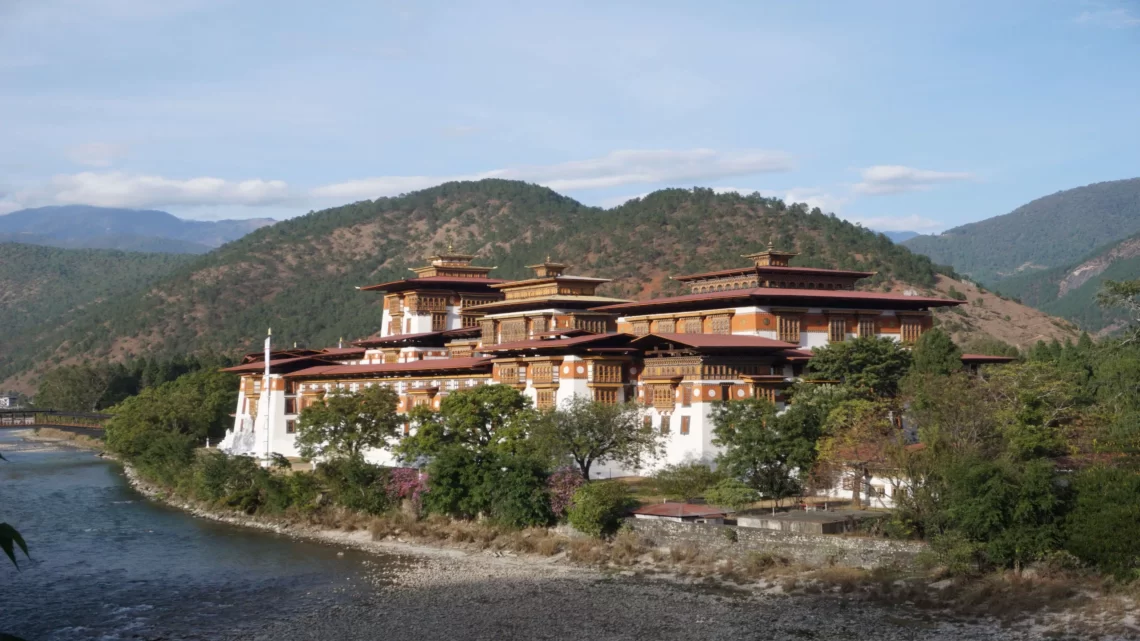
8 Days in Bhutan – The Perfect Bhutan Itinerary
If Bhutan is on your bucket list, this 8-day itinerary is your key to unforgettable experiences.
Bhutan, also known as the “Land of Thunder Dragon”, is a small landlocked country in South Asia. Bhutan has a lot to offer beyond the famous Tigers Nest monastery. Let me take you on a scenic journey that the Last Shangri-la offers on this 8-day Bhutan itinerary.
Since 2022, Bhutan has implemented an SDF(Sustainable Development Fee) for all tourists visiting from India or other countries. I will explain what the SDF is in detail at the end of this blog. For now, let’s dive into the itinerary.
Bhutan 8- Day itinerary overview
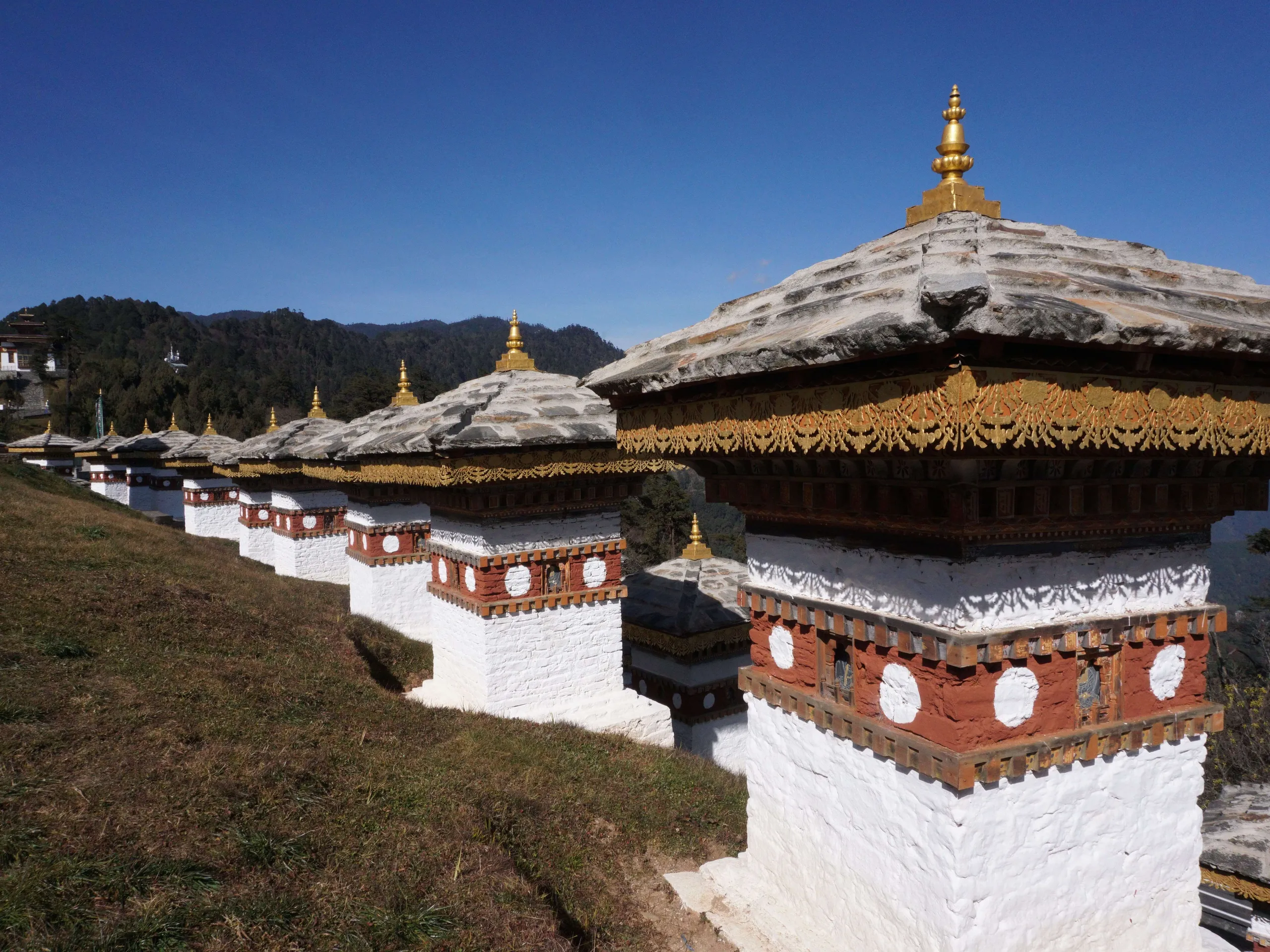
Unlike all the itineraries you find on the internet, we were happy to go beyond the regular touristic spots and see the raw scenic beauty of Bhutan.
1 Night in Phuentsholing
Visiting our first Buddhist temple in Bhutan – Zangtopelri
2 Nights in Thimphu
Overlooking Thimphu from the viewpoint, visiting the highest Buddha statue in Bhutan – Buddha Dordenma, Simply Bhutan museum, seeing the national animal of Bhutan(Takin), and experiencing the nightlife.
1 Night in Punakha
Visiting the Do-chu la Pass on the way to Punakha, Chimi Lakhang Fertility Temple, Punakha Dzong, the longest Punakha suspension bridge(180m), and a morning hike to Khamsum Yulley Namgyal Chorten.
1 Night in Phobjikha
Gangtey Monastery, spotting black-necked cranes on the Gangtey Natural Trail, Black-necked Crane Visitor Center, Lawa La Pass
2 Nights in Paro
Shopping in the streets of Paro, Tiger Nest Monastery, watching the locals take part in archery, dressing like the locals, and Paro nightlife.
While this blog will be my day-to-day experience of Bhutan, all the Bhutan tips and cost-related queries can be found here in my Bhutan travel guide.
How to reach Bhutan
By Air

Bhutan’s national carrier Druk Air connects Bhutan to the rest of the world. Paro is said to be one of the most dangerous airports to land at, and only limited pilots can land there. But it sure is a scenic flight, and if you’re flying from India, you also get to see Mt Everest on your flight.
The private Bhutan Airlines has now started direct flights from Mumbai and Bangalore every week.
PS: Be seated on the left side to see the Mt. Everest.
By Road
The best part about visiting Bhutan is you can also reach there by road. You can either fly in from any part of India to Bagdogra and then take a cab from there to the Jaigaon – Phuentsholing Border, which takes around 4 hrs from Bagdogra. Likewise, anyone from the regions nearby can take the train to Siliguri Station and cover the same road journey, which makes Bhutan very accessible.
And this is the route that we took.
Day 1: From Bagdogra Airport to Jaigaon Border
Unlike all the other international trips I had done so far, all of them solo, for the first time, I was doing an international trip with my friends. They hired a cab from Bagdogra Airport and picked me up from the Siliguri Station because I was visiting the Double Root Bridge before this trip.
While on the way, we stopped at a restaurant for a quick brunch and moved towards the border. As we were getting closer to Jaigaon, we saw the landscape change with a lot of tea gardens on the way. By 3 pm, we had reached the border and met our guides from Bhutan Druk Adventure, Kunezang, and Pema.
Since this was our last point in India, I withdrew some cash just outside the border and we walked into Bhutan. Yes, it was that simple. After security checks, we walked in with our guides and within minutes we were in Bhutan.
PS: Bhutan accepts Indian currency so there’s no hassle of carrying US Dollars.
Phuentsholing: Gateway to Bhutan
As soon as you enter Phuentsholing, you can feel the difference, that you have entered a new country. The buildings are different and there’s no honking and the roads are cleaner. Our hotel was very close and thus we walked there from the border gate.
I could finally see my dream of visiting Bhutan coming true, which had been on hold since 2020(Pandemic).
We rested in the room for a bit and then headed out to walk around the town in the evening. After casually looking at the structure of the buildings and checking out the shops, we reached a Buddhist temple that was quite lively at that point.
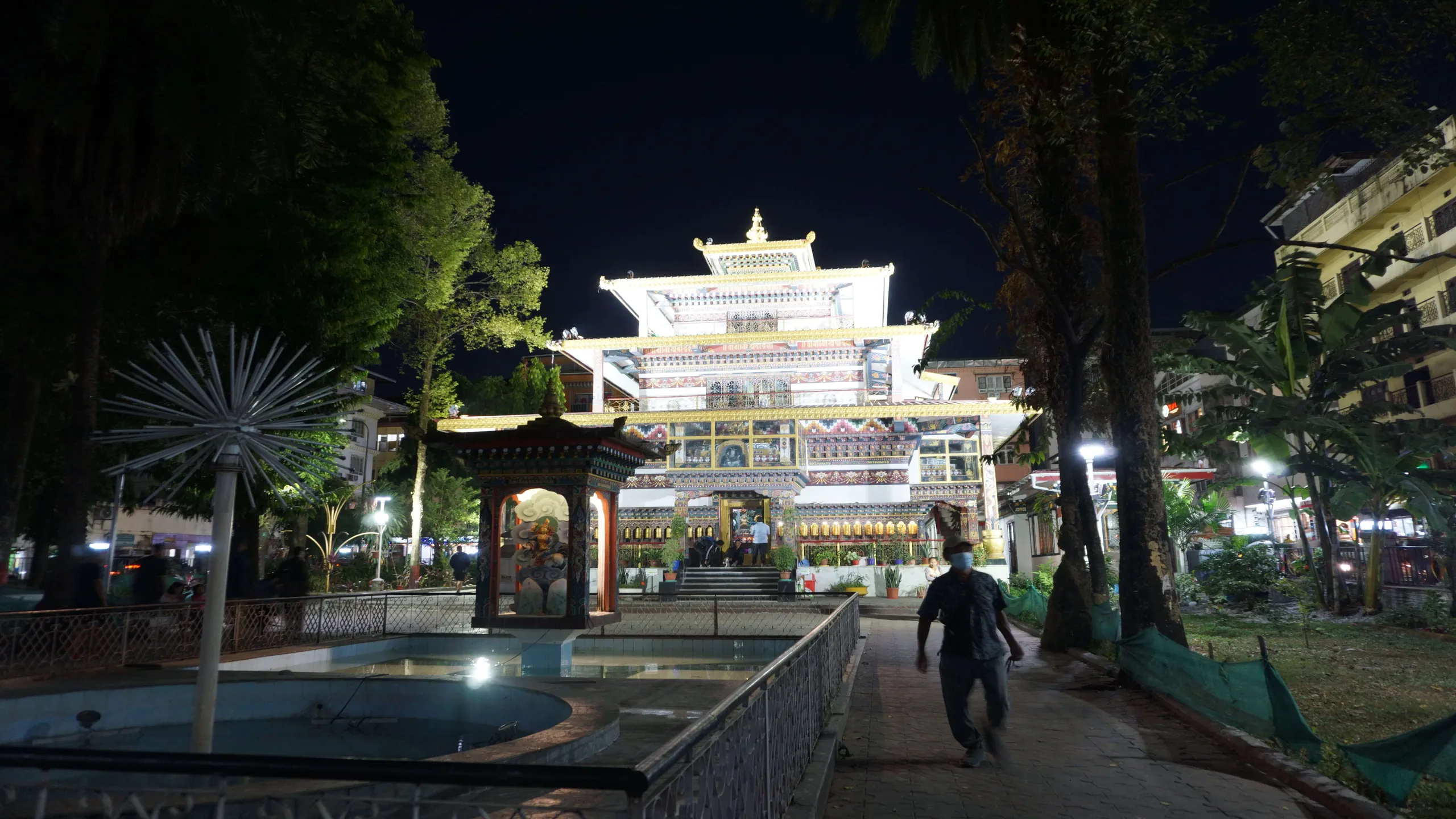
After randomly walking around and checking the shops, we headed back to our rooms. It was time for our dinner and when we reached the table, we found all the Indian dishes. Kunezang informed us that since Phuentsholing is right next to India and a lot of Indian tourists visit Bhutan, we will find a lot of Indian food on our trip.
This was a good thing but we were equally excited to try the local Bhutanese cuisine.
Fact: To keep the ancient Bhutan architecture intact, the government of Bhutan has made sure that all the houses follow the same architectural style.
Day 2: Onwards Thimpu
Since this trip was during the first week of December, it was already a little cold in Bhutan and our rooms had heaters in them.
The next morning, after a quick mix of Indian and English breakfast, we left the hotel. It was time to head to the capital, Thimphu. It was going to be a long journey of 5-6 hours.
We first headed again to the border to get the permits and our sim card.
I was already enjoying the roads in Bhutan and how organized everyone was while driving. Within 20 minutes, we were overlooking the border of India and Bhutan. The best part was we could stop anywhere on the way where we got a nice view from or near a small shrine. We could also find multiple spots with prayer flags on the way.
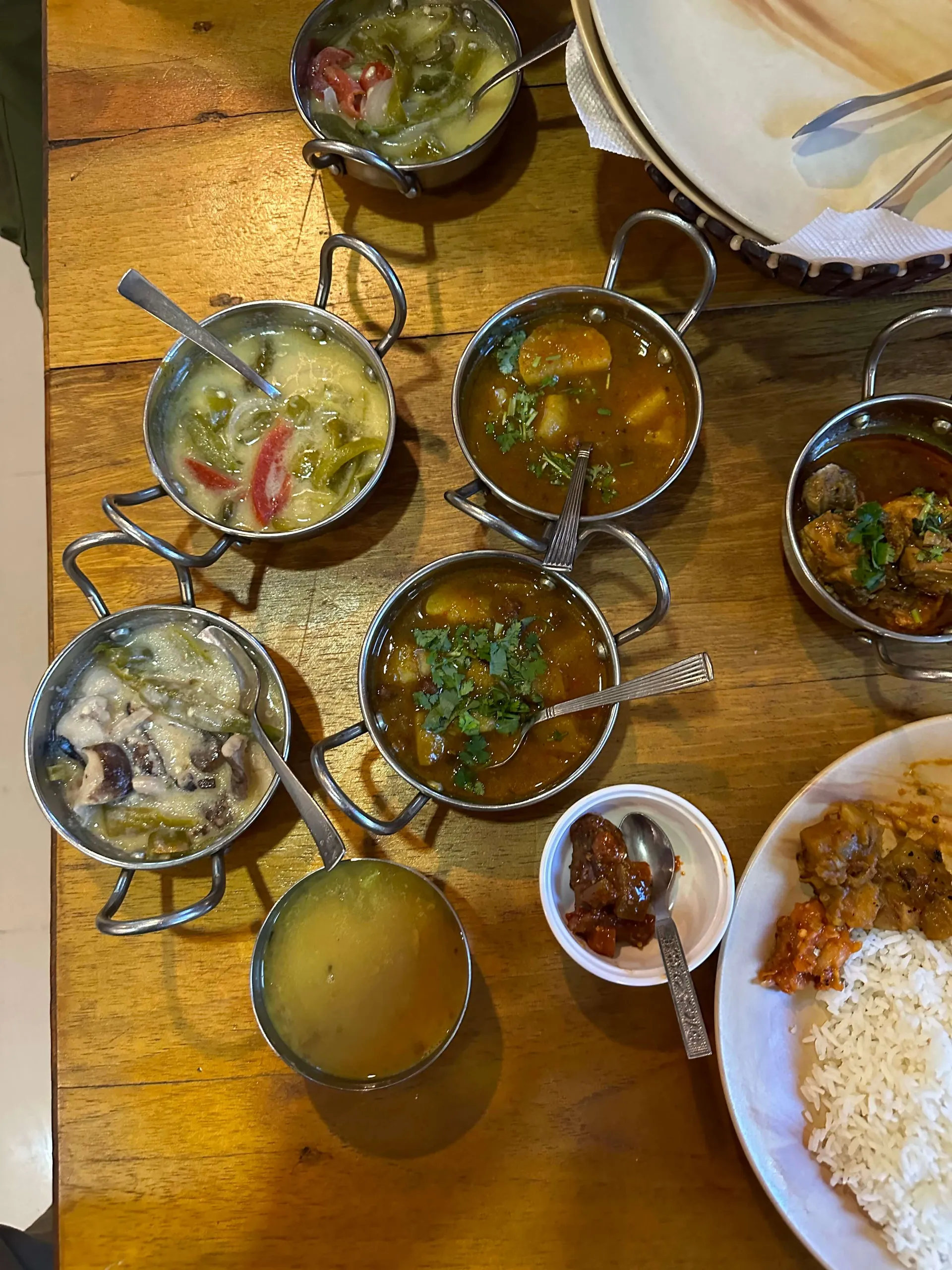
We were either looking outside the window or taking a nap throughout the ride. For lunch, we stopped at a local restaurant and were finally going to have the national dish of Bhutan – Ema Datshi.
While it is a very simple dish made from chili and cheese, the taste was really delicious. It’s usually eaten with red rice, but you can have it with Chapati(Bread). Once we were done with lunch, we were back on the road to reach Thimphu.
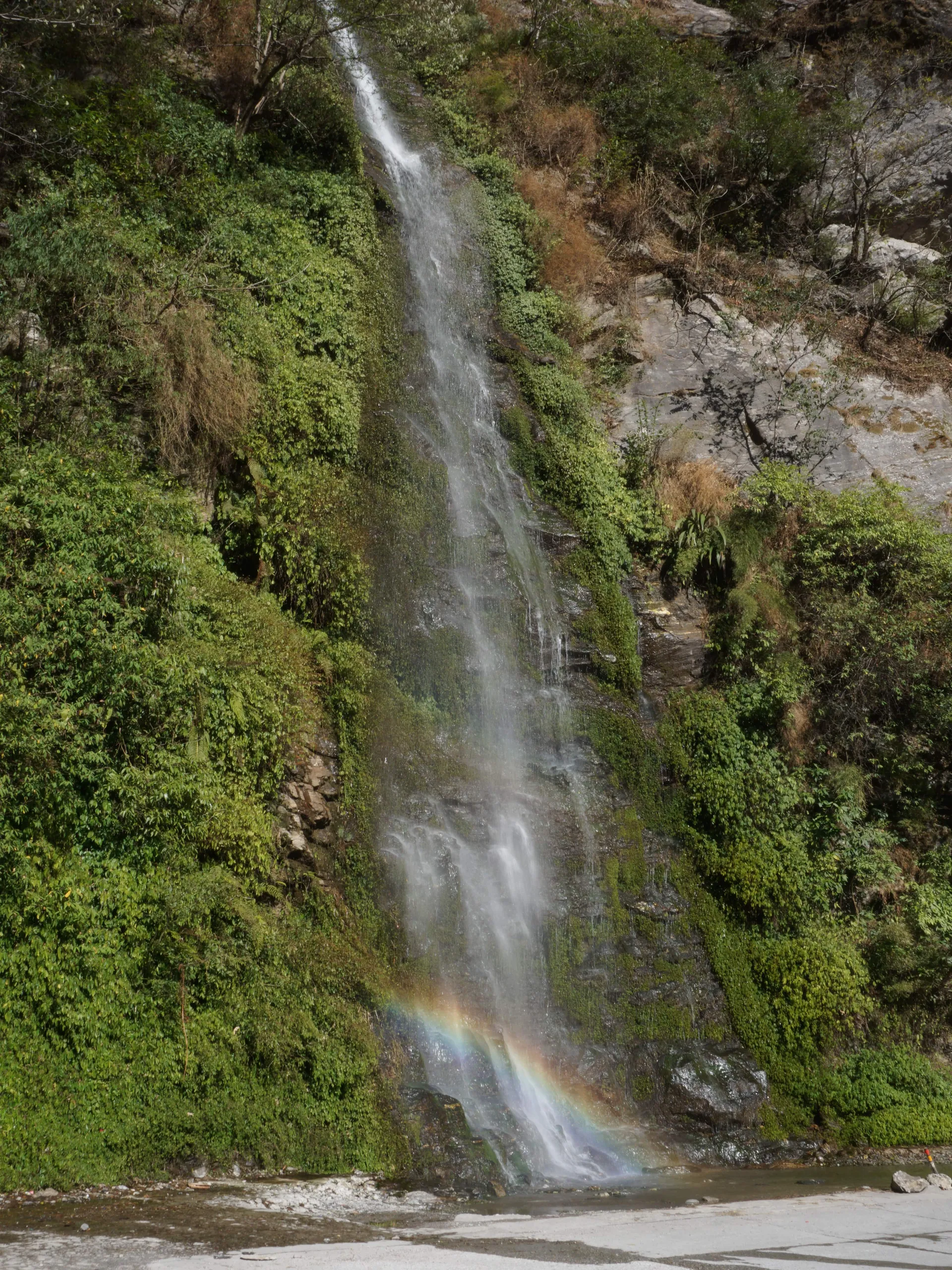
Overlooking the beautiful capital city of Thimphu
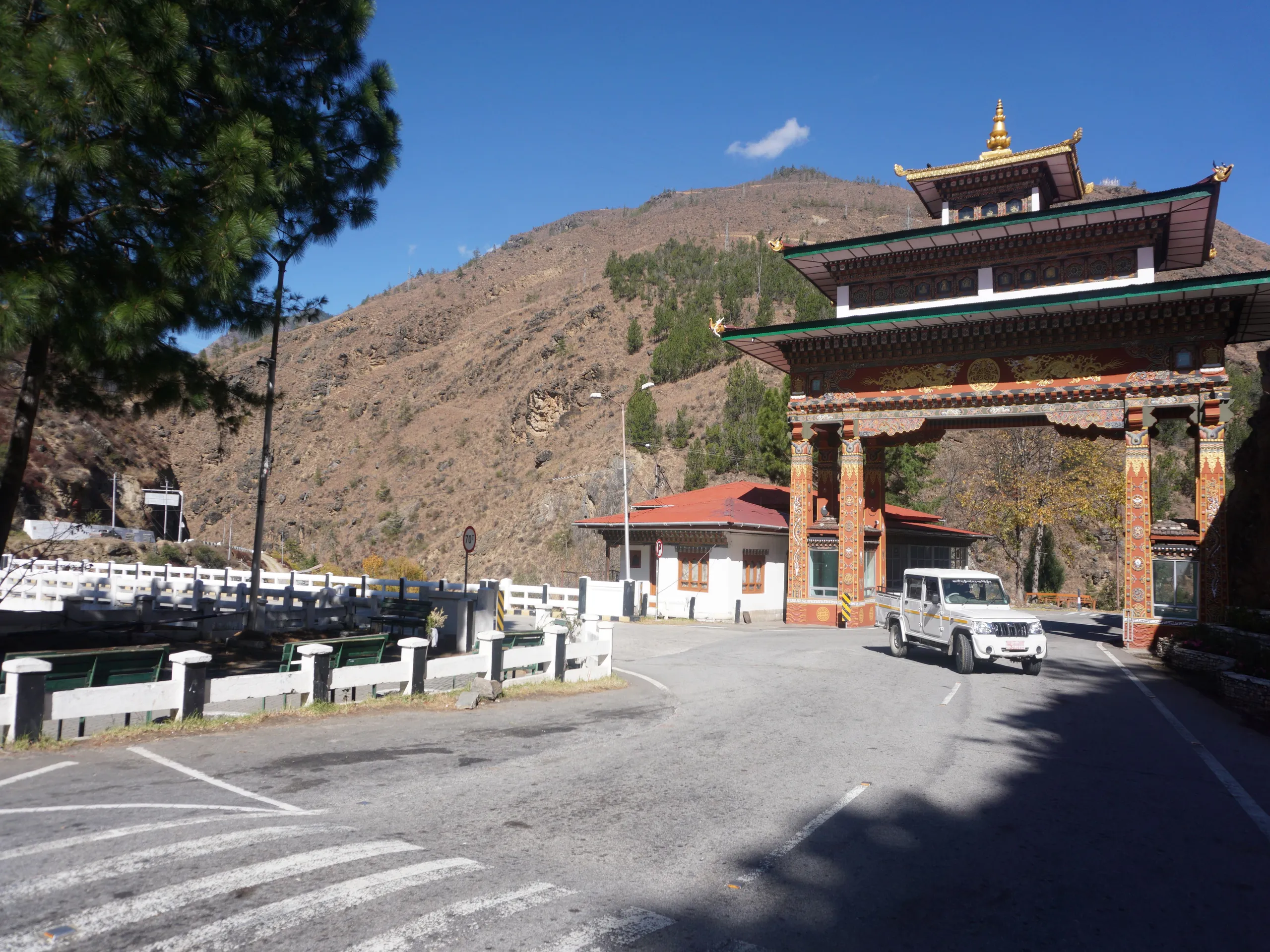
We reached a point where we saw a small intersection, the road on the left took you to Paro and the right went to Thimphu. We were getting closer and closer to Thimphu as we started seeing the buildings and houses.
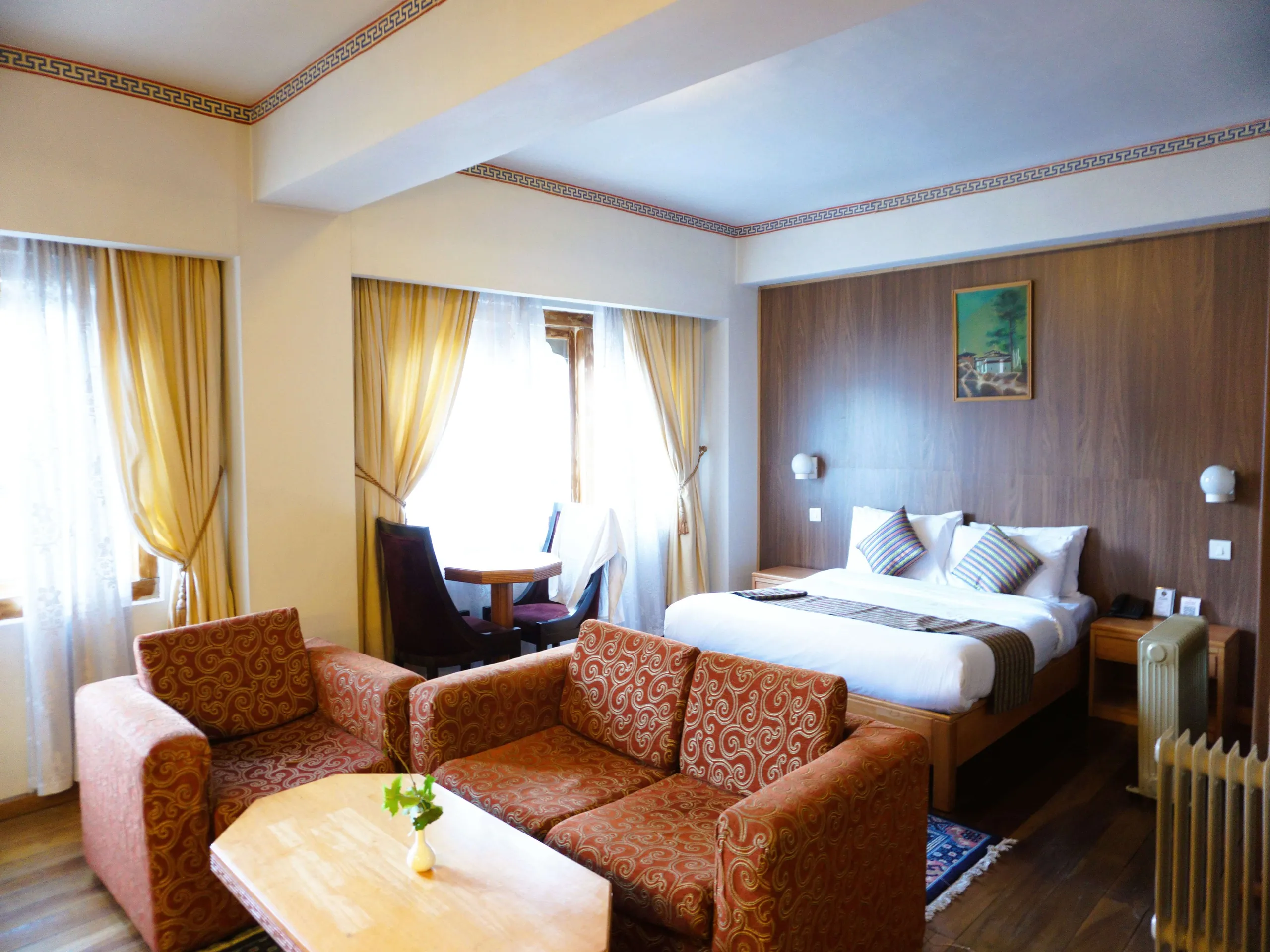
The roads were so clean and no one honked while on the road. Kuenzang then informed us that Bhutan doesn’t have any traffic signals in the country. Within another 20 minutes, we were at our hotel, where we met Rinzin, who is the owner of Bhutan Druk Adventure.
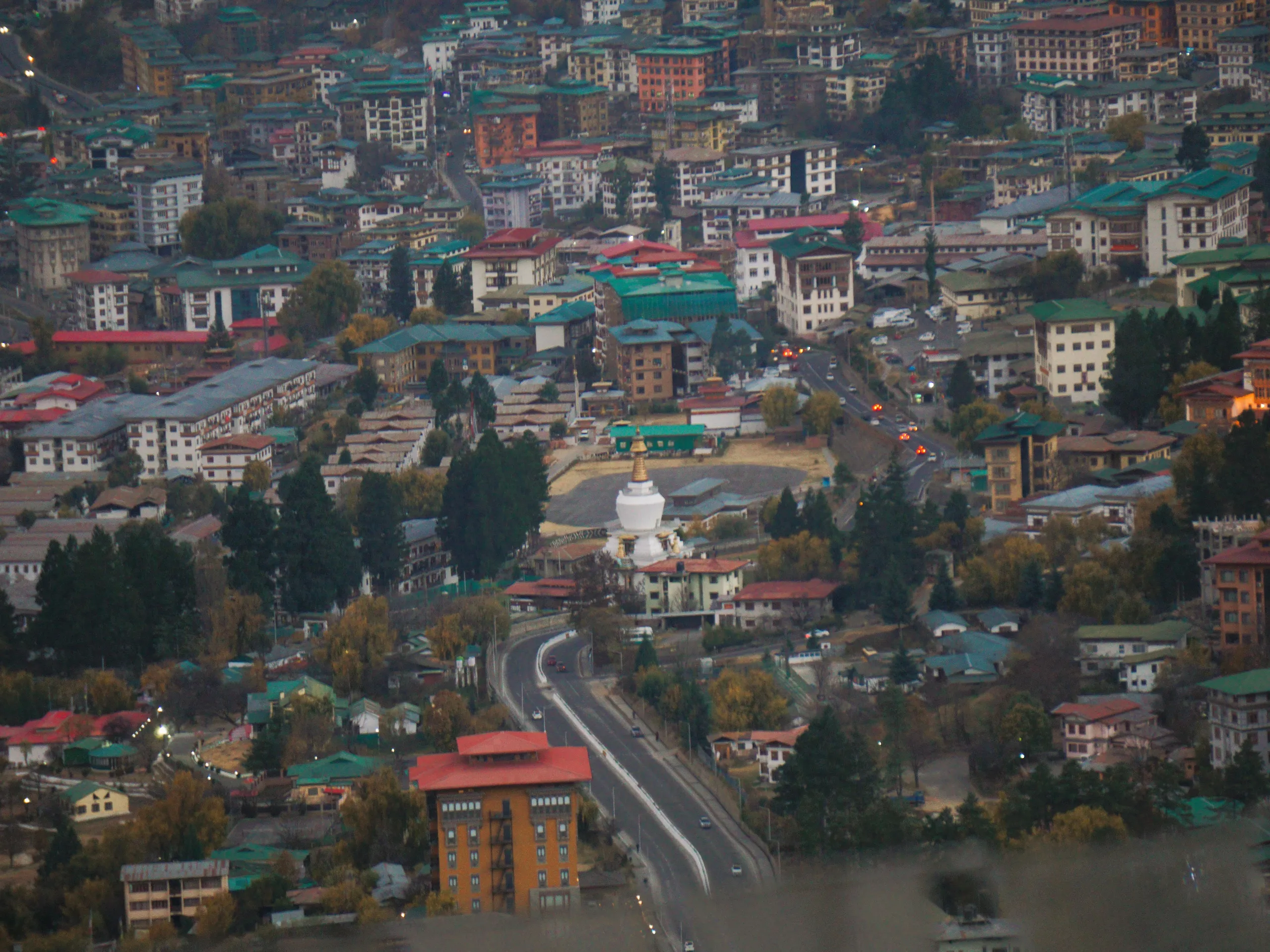
Since there was still some daylight, Rinzin took us to the Radio tower. The view from there was so amazing, overlooking the Thimphu valley. We could also see the Buddha Dordenma Statue which we would be visiting the next day. It was also time for sunset and we could see the different hues.
Once we were back at the hotel, we relaxed and had dinner at the hotel. It was still 9 pm and Rinzin asked us if we wanted to go out and see the nightlife of Bhutan. How could we say no, despite how cold it was?
Exploring the nightlife of Bhutan

We first went to Mojo Park and saw live performances happening there, they were not only singing English but Hindi songs as well to our surprise. Rinzin informed us that on Wednesdays, Fridays, and Saturdays, all the pubs are packed. We went there on a Monday and there was little to no crowd.
After spending some time there, we then went to a karaoke bar. This place was more lively and had more people enjoying, singing, and drinking. Since they were playing only local songs, we sat there for a while and then headed back to the hotel.
Day 3: Visiting the famous Buddha Doderma Statue

The next morning, we had an early breakfast and were excited as the day was filled with visiting different spots across Thimphu. As soon as we reached the Buddha statue, we were just amazed at how huge the statue was(55m tall). We then visited the temple which is just below the statue.
We then spent some time out in the courtyard which generally houses events and ceremonies.
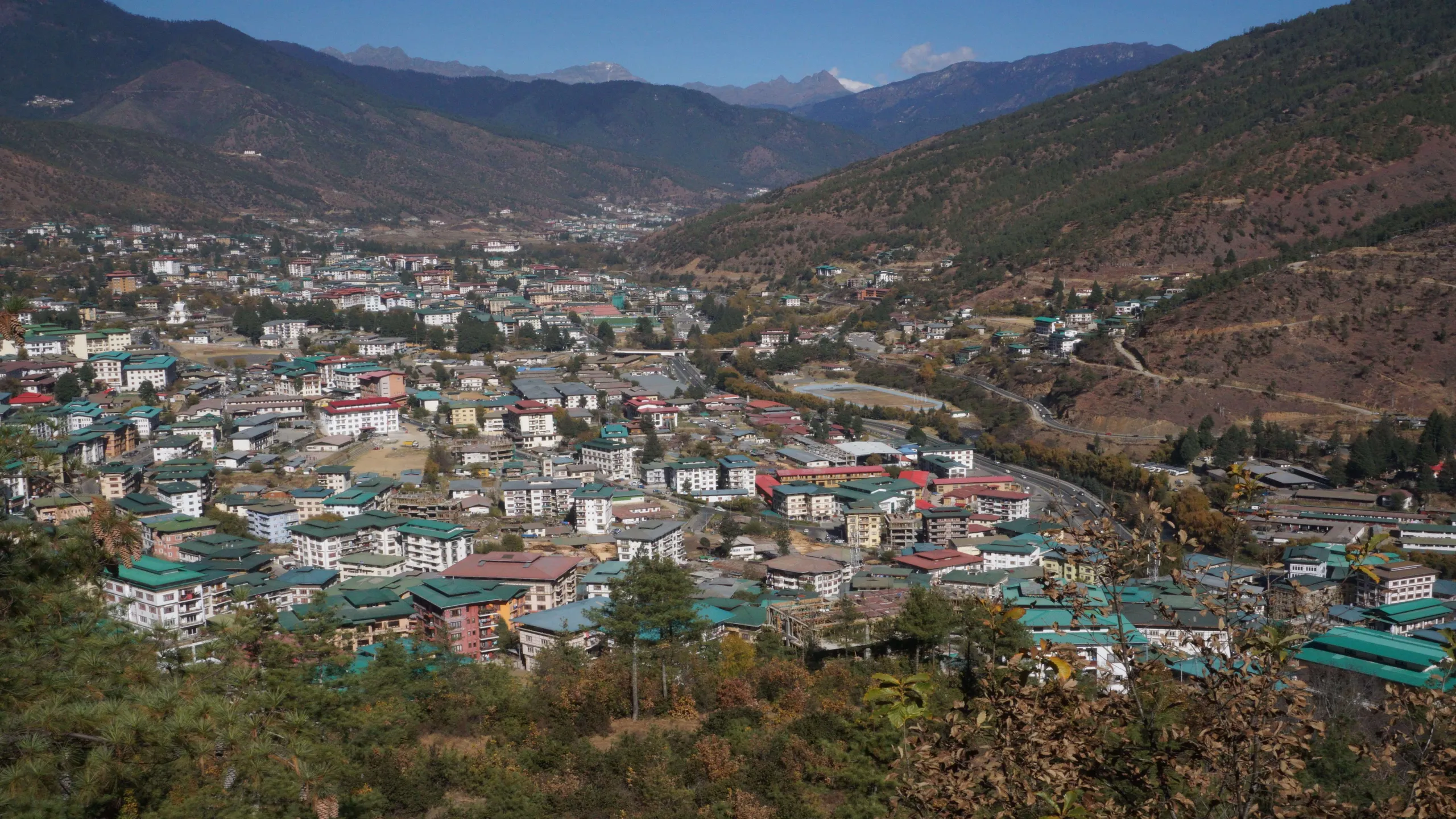
You also get a great view of the Thimphu Valley from here. We then went to the National Memorial Chorten which was bustling with local people. This corten is a famous spot amongst the locals who come here to worship. We had a glimpse of this from outside and headed to the next spot.
Experience the culture of Bhutan at Simply Bhutan

If you are coming to Bhutan, you can not miss this place, it’s called Simply Bhutan. It is a museum that displays the history, cuisine, and traditions of Bhutan.
As soon as we entered, we were treated to local rice wine, which is also called arra. A representative from the museum will then explain about the different Kings of Bhutan while you enjoy your drink.
After that, we headed to an open space which showed how the locals damped the floor to make houses. In the same process, people were able to find their partners while working together. We also saw different masks that were worn by people during Tsechhu.
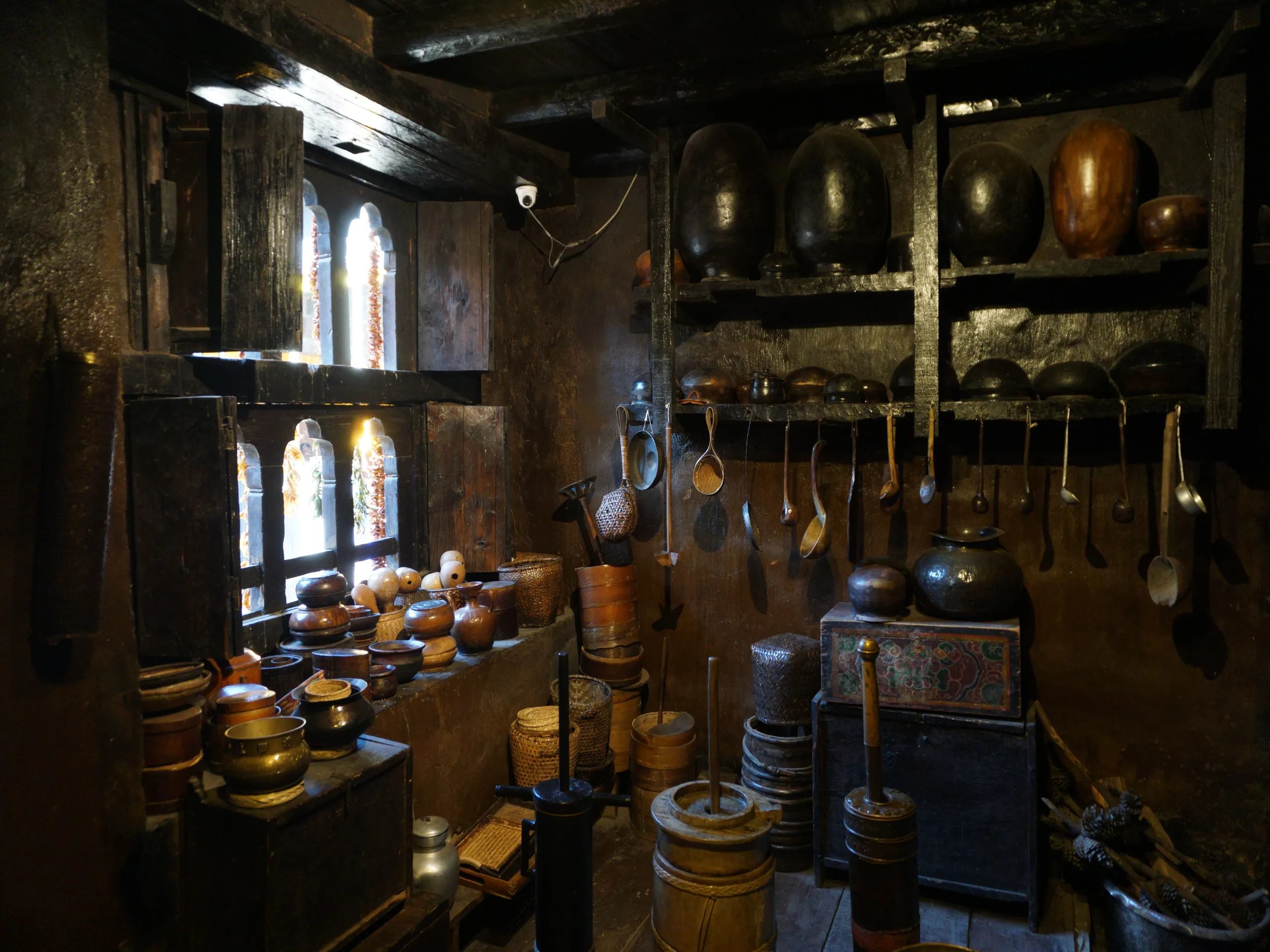
Something that is quite common in Bhutan but might make you feel awkward is that Bhutanese people worship the phallus and you’ll find buildings with phallus drawn on them or souvenirs in the shape of phallus. We also saw how the old houses existed in Bhutan and the different utensils they used. You can also meet Tsering Pema who is famously known as the foot artist.
After this, we were given butter tea and sweet rice as snacks while we enjoyed the dance performance by the locals, at the end we also joined them.
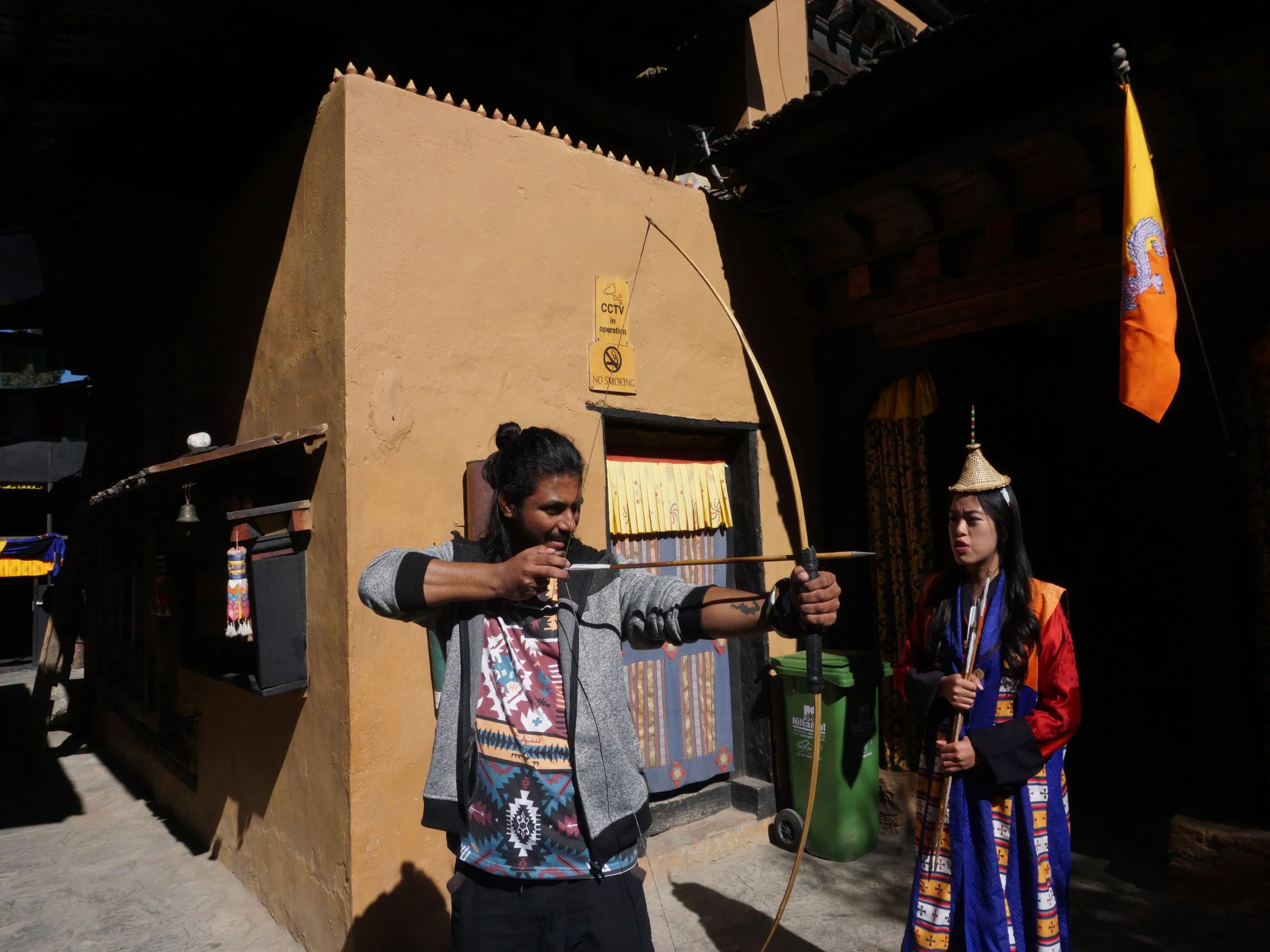
In the last section of the museum, we tried archery which is also the national sport of Bhutan. If someone hits the aim, everyone comes together and dances. While we missed the aim every time, it was a piece of cake for Pema and Kuenzang.
Exploring various attractions in Thimphu
It was already time for lunch and we were back in the city center. We liked the ema datshi so much that we decided to have it once every day. After spending some time in the center and sitting in the sun which was very much needed, we headed to the next spot – Royal Takin Preserve.
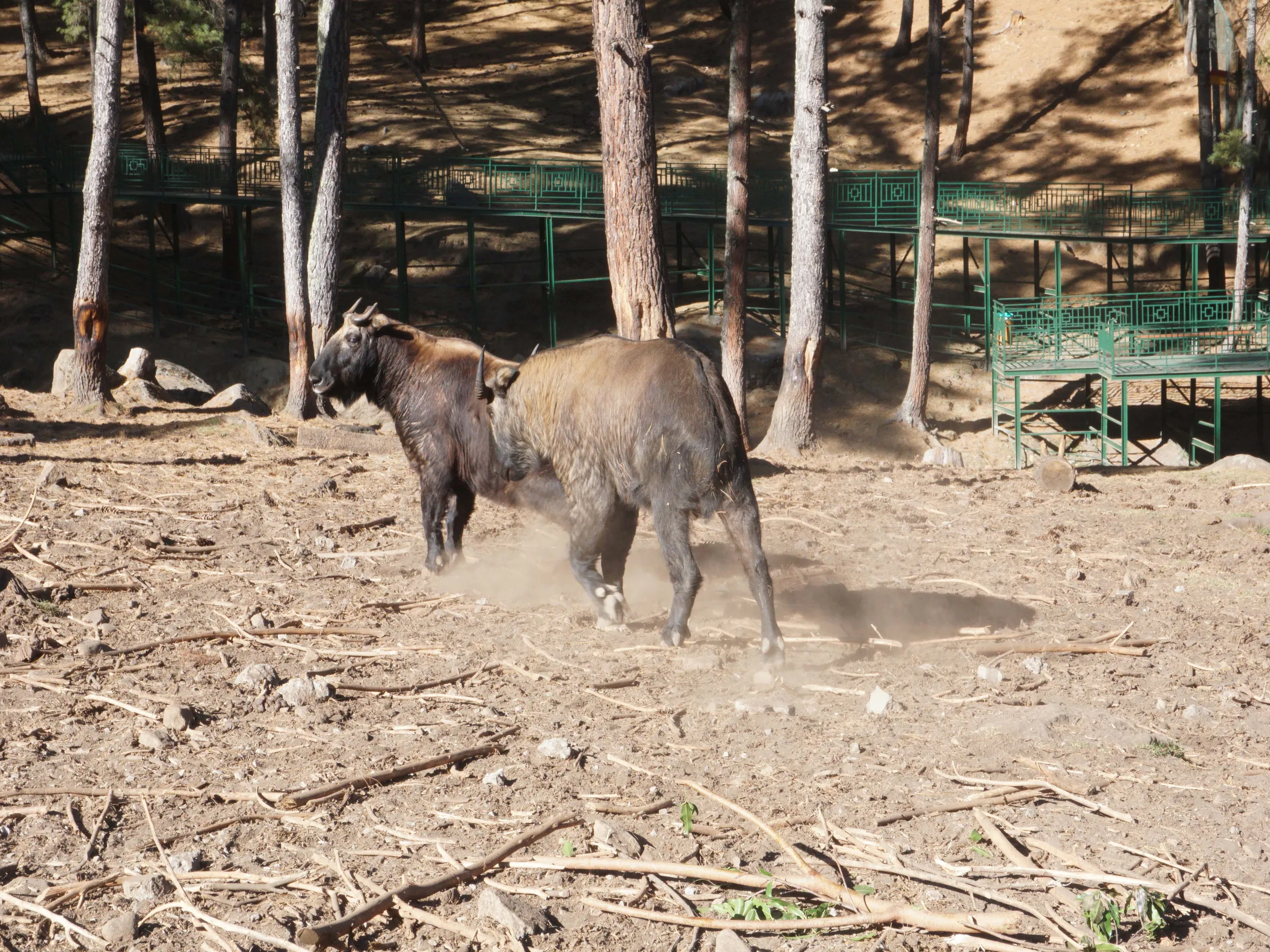
Takin is also the national animal of Bhutan and resembles a goat and cow. There is a legend behind Takin, in the 15th century a divine madman was asked to perform a miracle, when he agreed and asked to have a full goat and cow for lunch, everyone agreed. After having eaten the flesh, the madman fixed the bones of the goat’s head into the cow’s body and immediately the animal came to life and began grazing the meadows.
After this, we also saw Bhutan’s king’s house from far away and then went to the paper factory.
By evening we were very close to our hotel and thought to check the duty-free shop in Thimphu where you can buy cheap alcohol, chocolates, and gold. While Bhutan is promoted for its gold tourism, I have explained in this blog if gold is really cheaper in Bhutan.
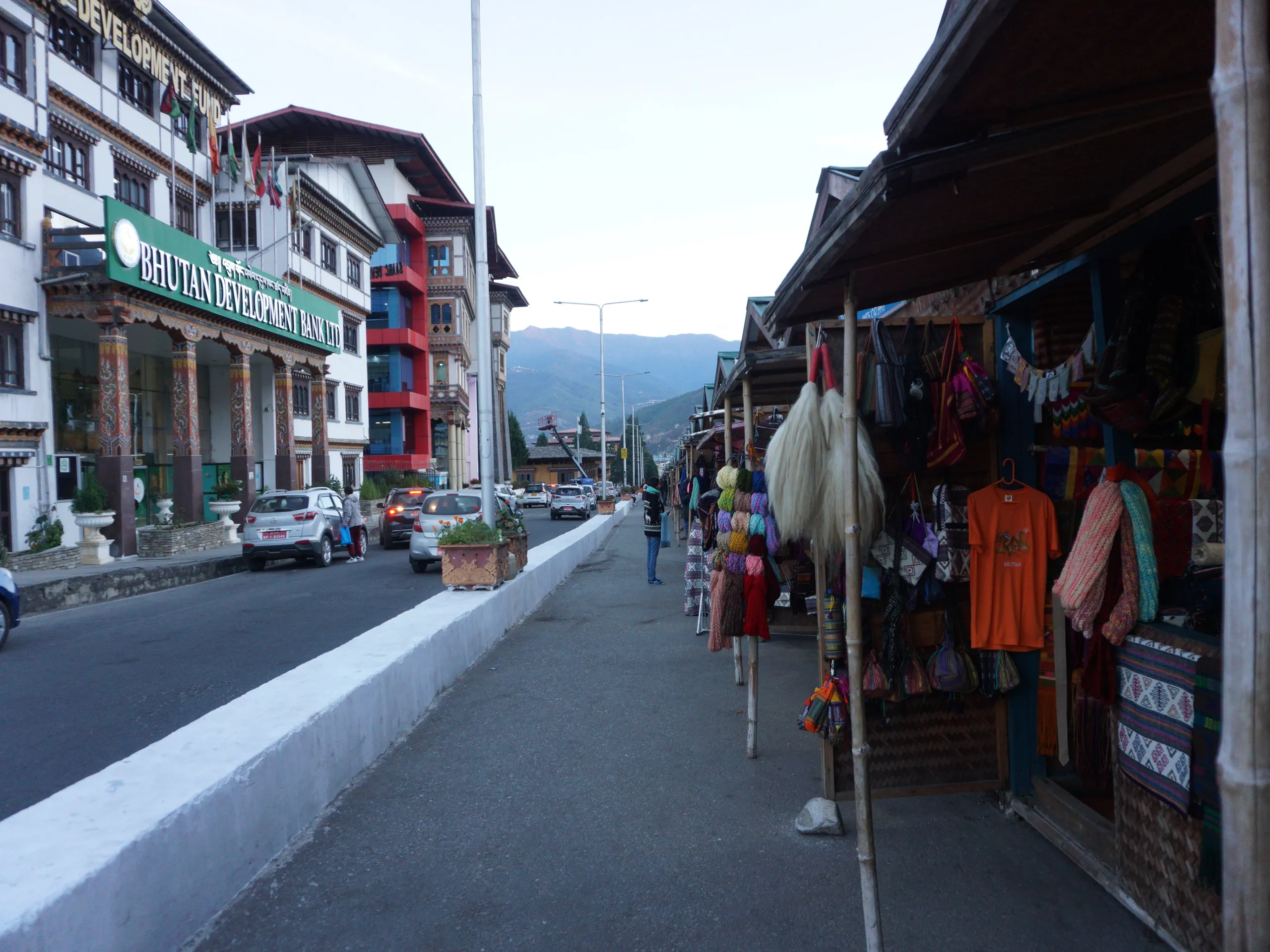
We then went to the shopping street in Thimphu to buy some souvenirs. At night since we didn’t have a lot to do, we walked near our hotel and found a shop selling momo and we had to try them. They were so good and spicy but we didn’t eat much as we had to head back to the hotel for dinner.
Day 4: Do Chu La Pass the 2nd highest pass on our trip
The next morning, my friend woke me up early and then we went for a walk. We could see a football ground nearby and since both of us love football, we wanted to see it. Little did we know this same ground was used by the national league of Bhutan to host the matches. Playing football with the mountains in the backdrop, definitely need to check this off my bucket list. After coming back to the room we had breakfast and were ready for our day.
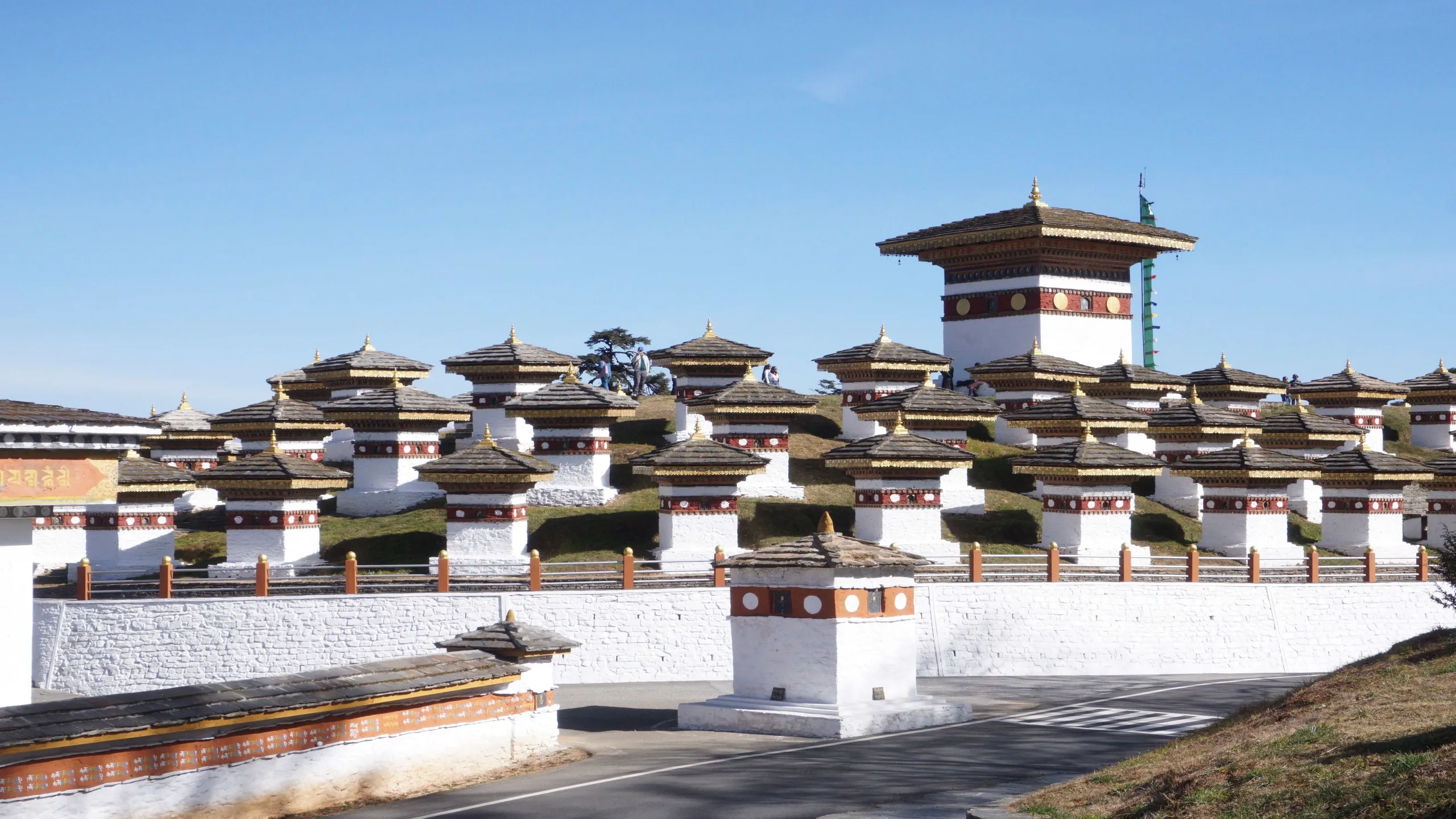
We were then en route to one of the most iconic spots on our Bhutan itinerary, the Do Chu La pass. Do Chu La Pass is famous for its 108 memorial chortens(stupa) in remembrance of the sacrifices made by Bhutanese soldiers. The pass is at a height of 3100mts and we could also see the tallest mountain of Bhutan from here, Gangkhar Puensum. It also is the highest unclimbed mountain in the world.
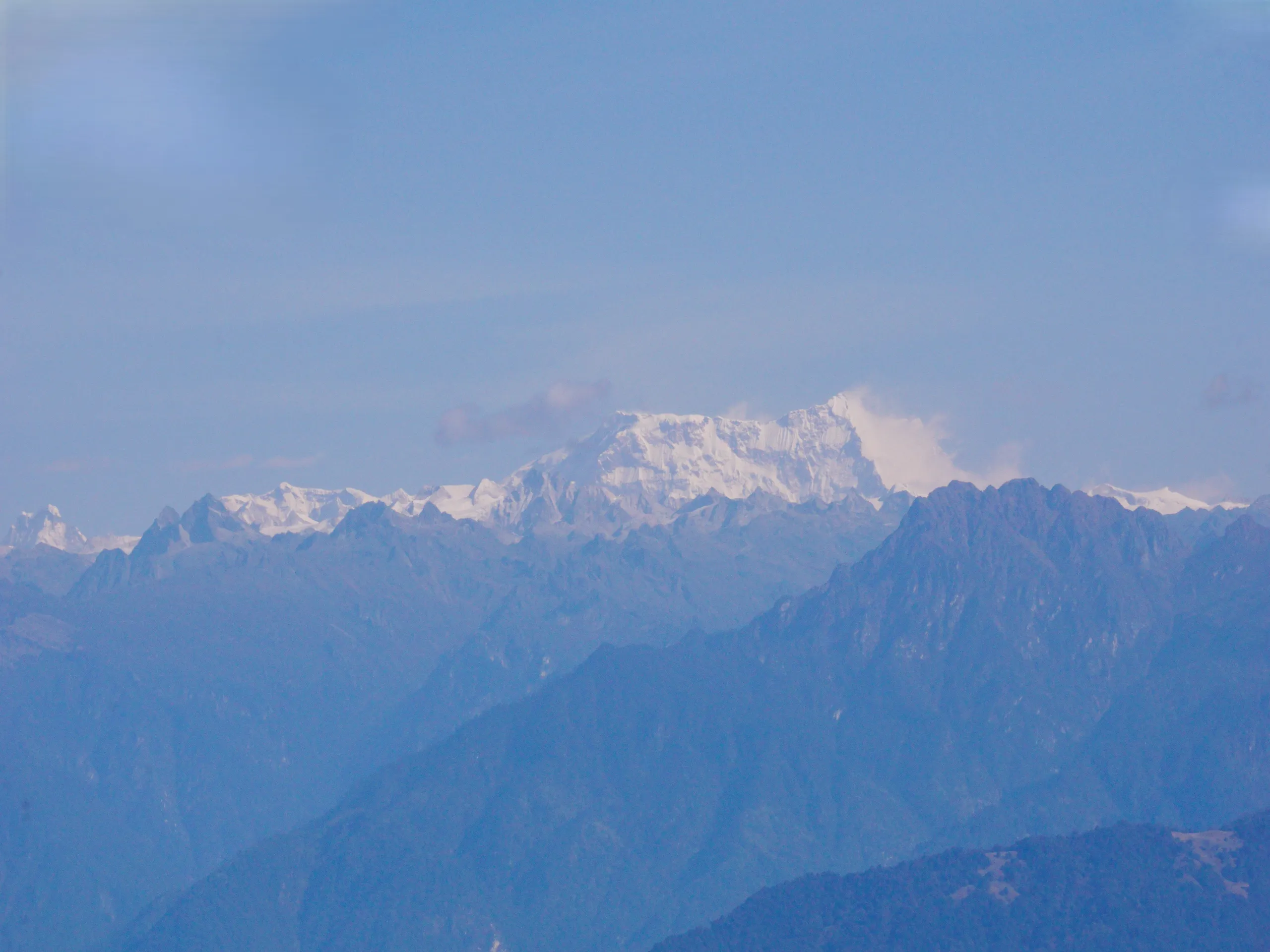
To escape the crowd, we found a few walking trails near the chortens with even better views. There is also a cafe, where you can have some light snacks or coffee. We spent easily more than an hour here to take pictures and enjoy the beautiful mountain views.
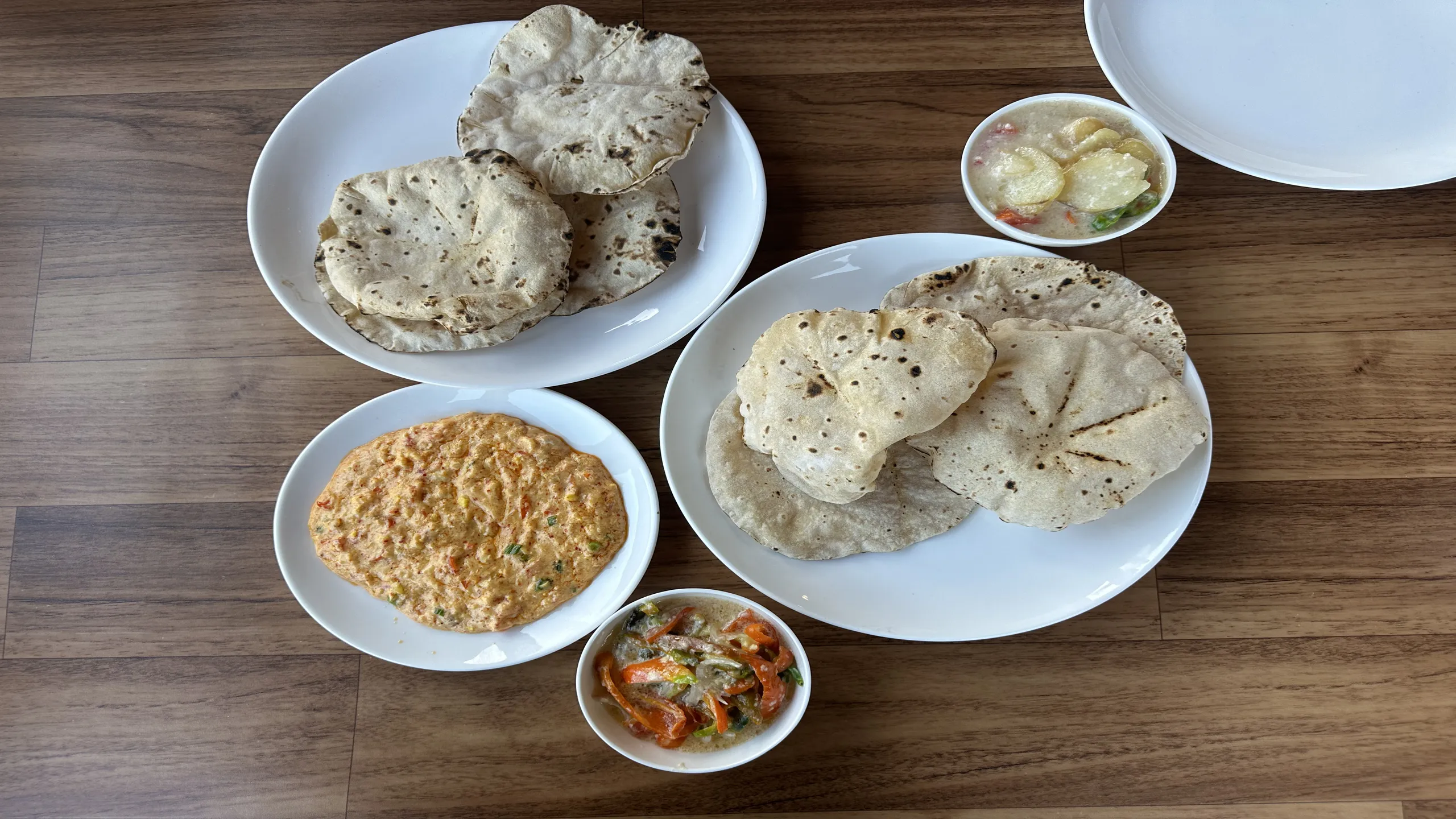
After this, we were on our way to Punakha. On the way we stopped for a quick lunch, and what did we have? Any guesses? Ema datshi obviously!
Visiting the temple of fertility and the first glimpse of Punakha Valley
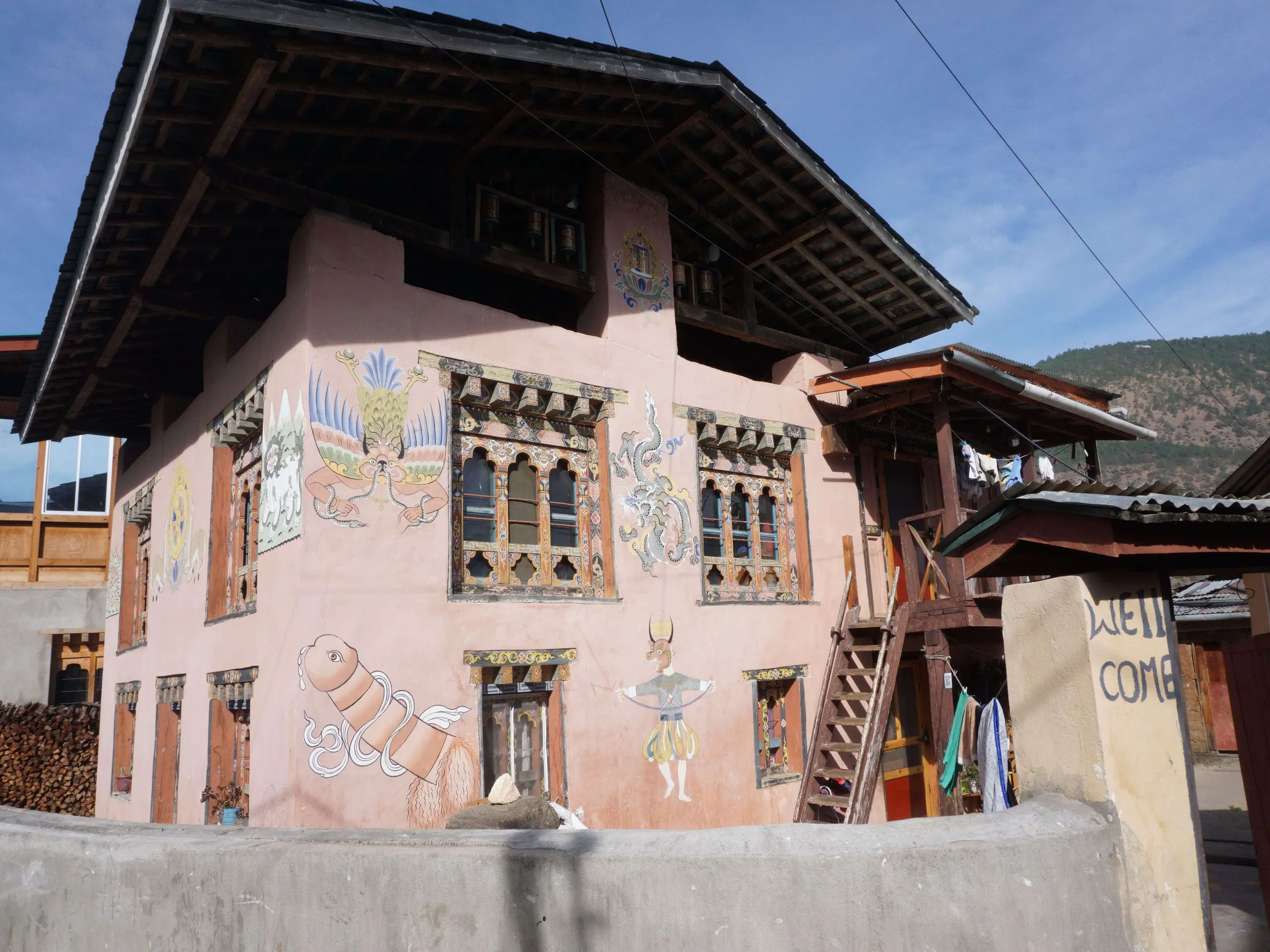
If you’ve heard about Bhutan, I’m sure two things always come up. The Tiger’s Nest and the Temple of Fertility. Just after lunch, we were on our way to the temple of Fertility. While we could directly reach the bottom of the temple, Kunezang thought we should walk through the village, and it was a really great experience walking in the small lanes across the paddy fields and then seeing how each house had a phallus drawn on it. Within 10 mins we were at the starting point of the temple hike, which was another 5 minutes to reach the temple.
This is the temple of the same divine madman who I also mentioned when visiting the Takin Preserve.
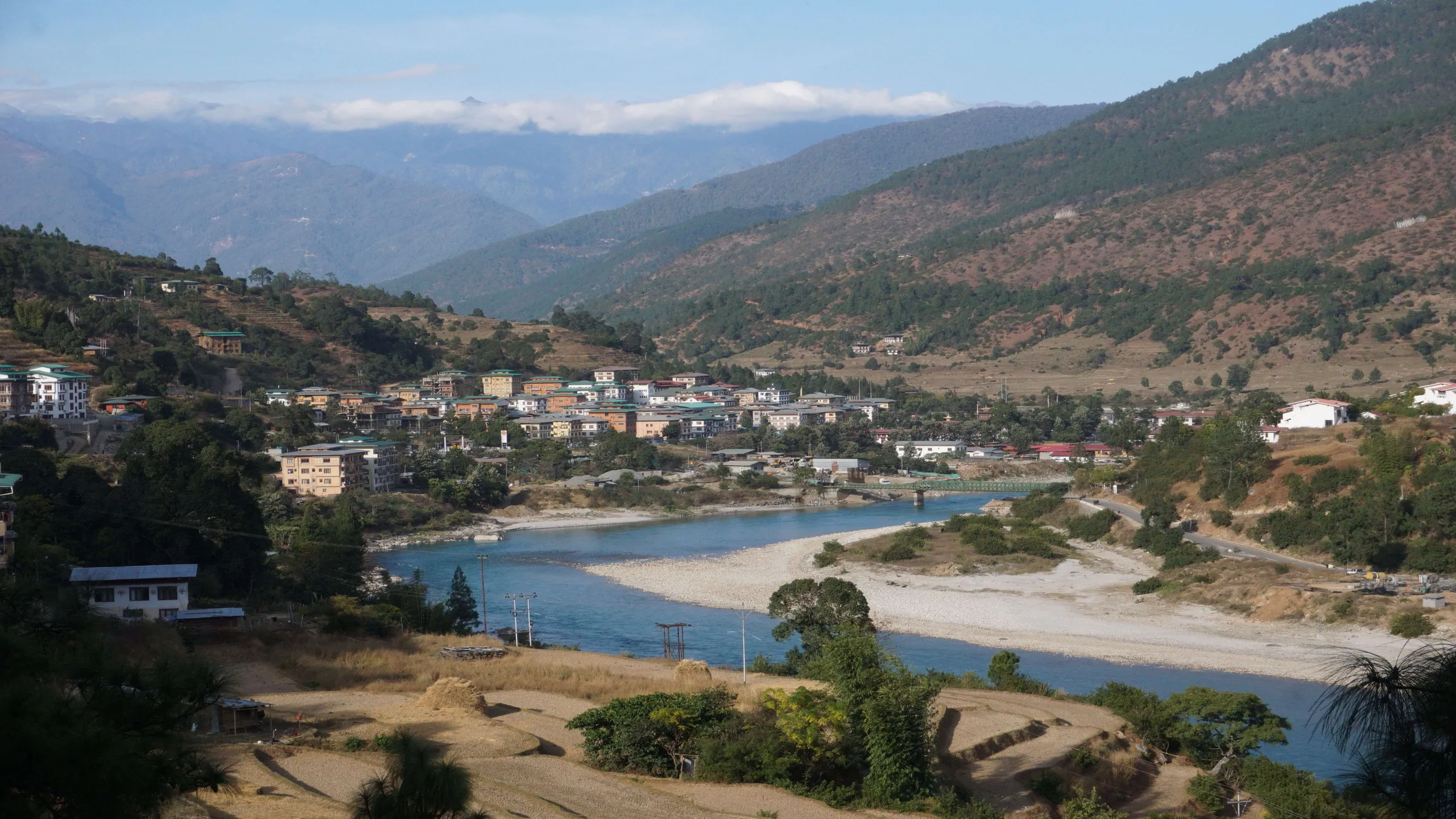
We were then on our way to Punakha, and the view just kept getting better with the Puna Tsang Chu(Sankosh River) on the side.
The oldest and largest Dzong in Bhutan: Punakha Dzong
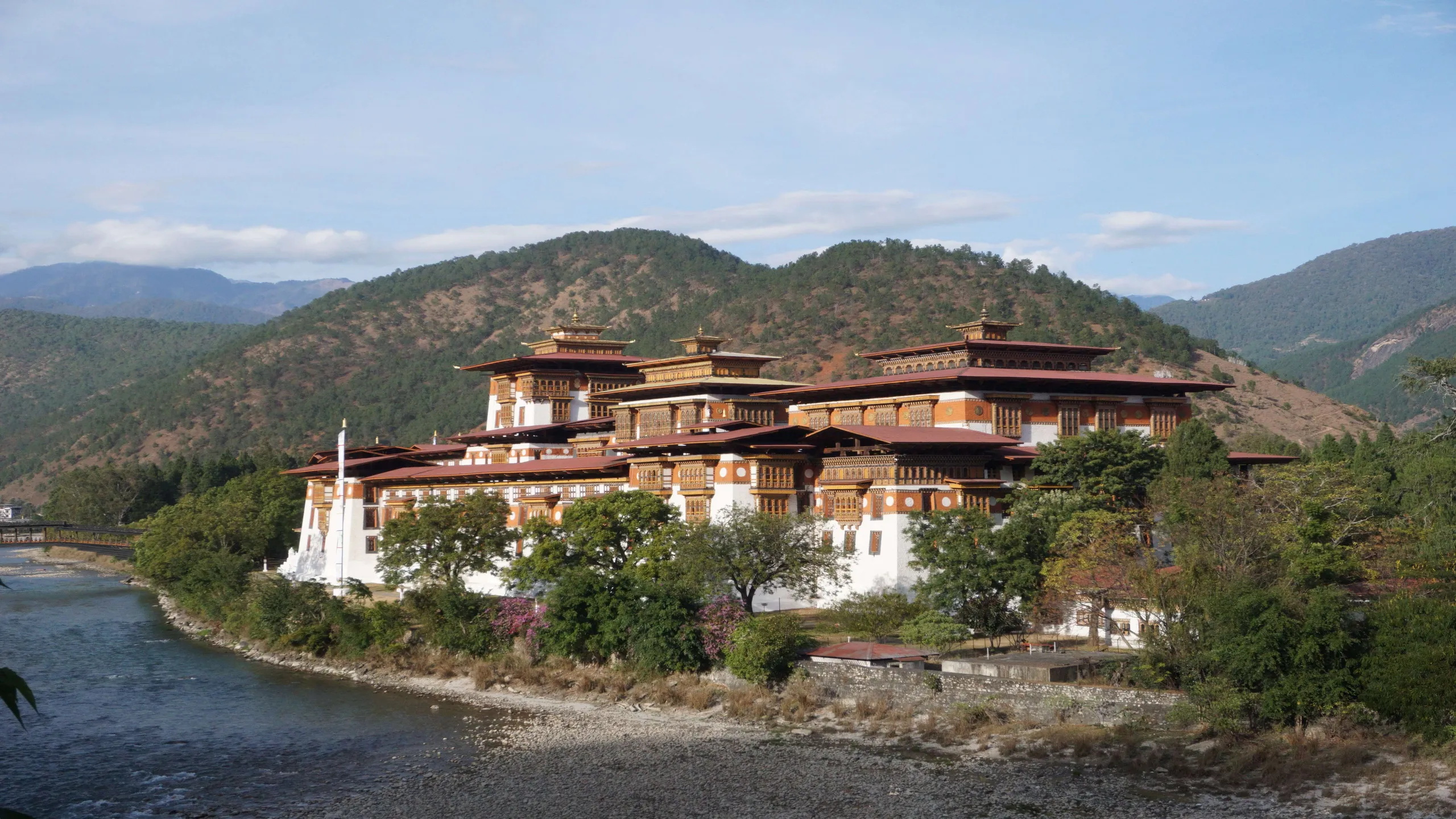
As soon as we had the first glimpse of the Punakha Dzong, we were just amazed looking at it. It was the most beautiful building that we had seen on our complete trip so far. At first, we stopped just across the road to capture the Dzong with the Mo Chu(Female River)flowing right in front of it.
We later entered the Dzong and were just mesmerized by the beauty of the place. The Punakha Dzong is the oldest and largest Dzong in Bhutan. Punakha was earlier the capital of Bhutan, until 1955 and then it was shifted to Thimphu.
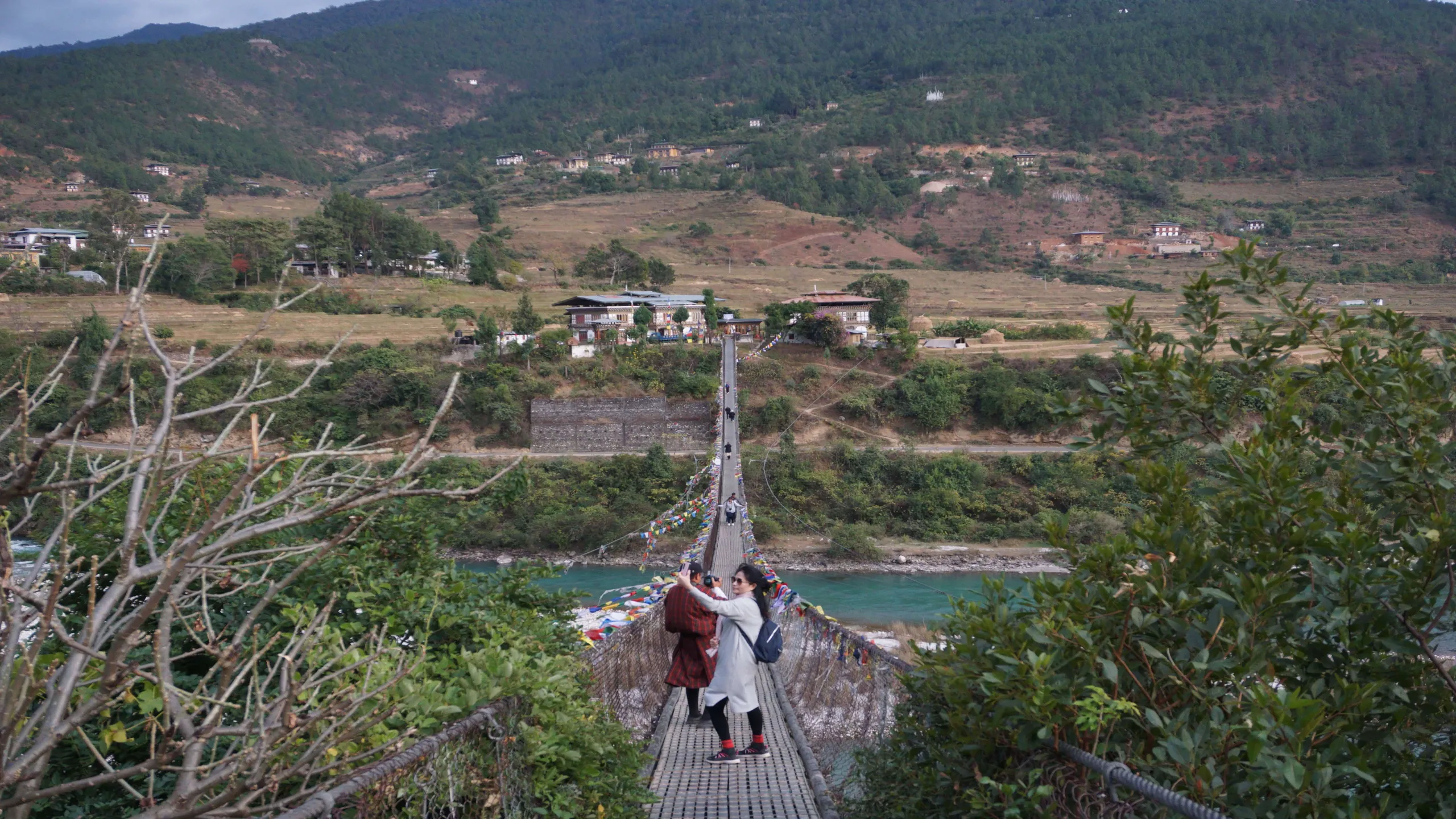
We wanted to spend more time here but it was almost time for sunset and we had to visit the suspension bridge. The suspension bridge is just 15 minutes away from the Dzong.
I was not scared to walk on the bridge, but I was scared about the mobile phone. This is also the longest suspension bridge in all of Bhutan measuring 180m in length. The bridge is over the Po Chu(Male River). For adventure lovers, you can also try river rafting here.
When we were there, we also realized that the King of Bhutan was also there, but we never got a chance to meet him.
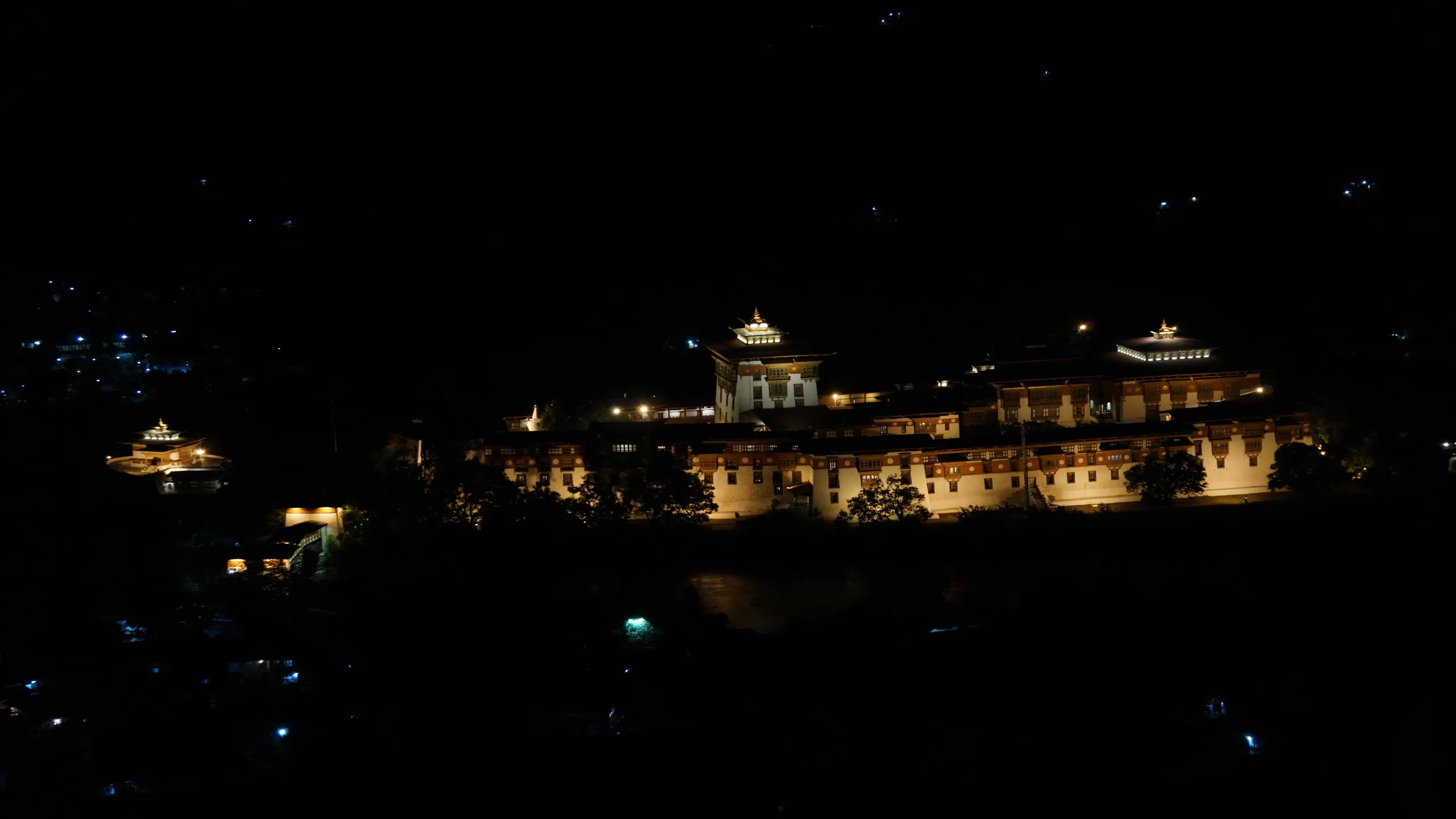
We were soon on our way to the hotel as it was starting to get dark. The hotel had one of the best views of the Punakha Dzong at night with all the lights.
Day 5: Short morning hike to Khamsum Yulley Namgyal Chorten
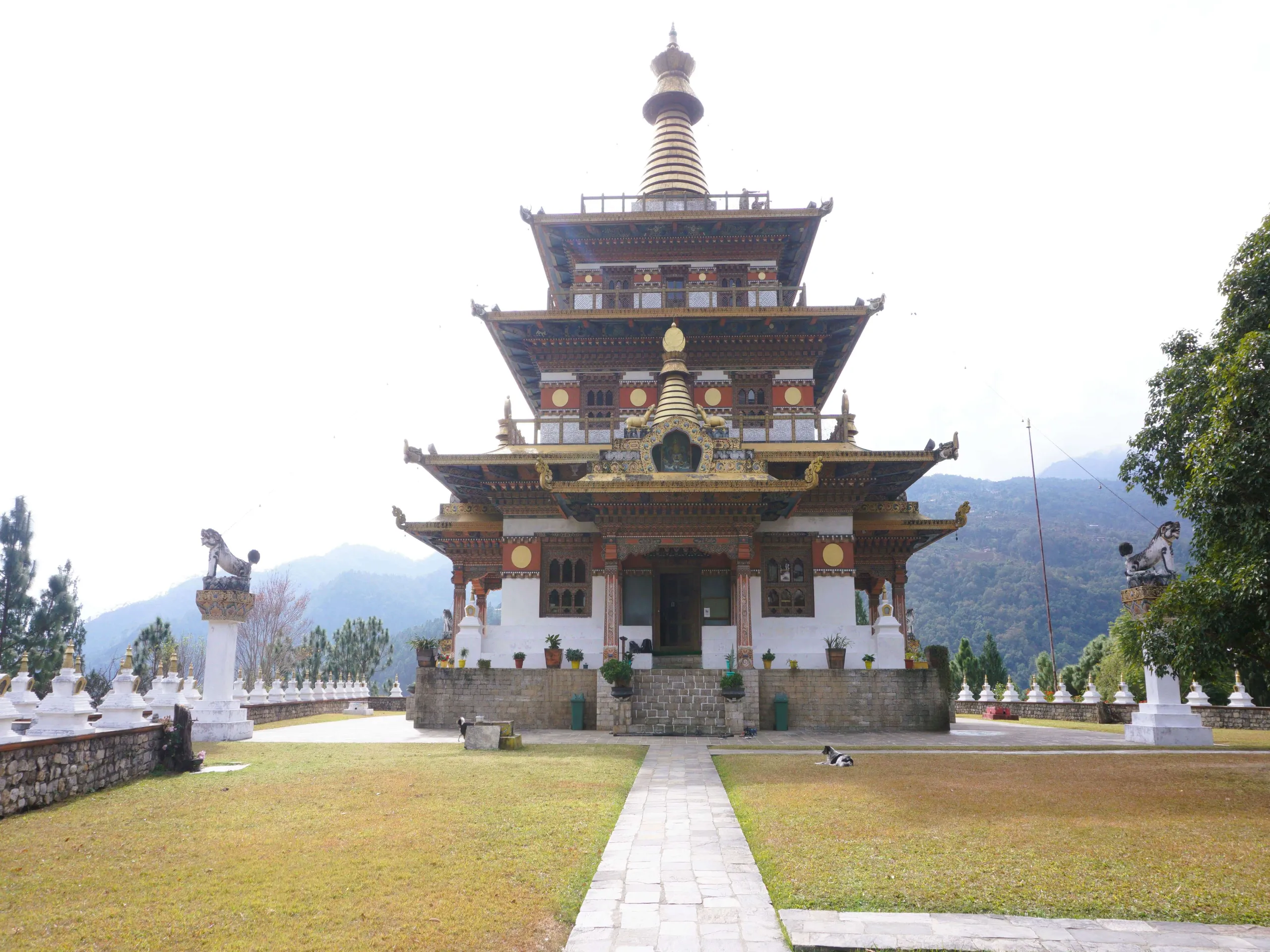
The next morning, we woke up early as we had to leave for a short hike. It was a short hike of 30 minutes to the top where we could find a Chorten(shrine). The hike was very beautiful and started by crossing a suspension bridge and then crossing the fields.
This hike was not initially on our itinerary, but when we met Rinzin and told him how much we love hikes, he mentioned this one. From the top of the Chorten, we could have a beautiful view of the Punakha valley and the river.
We were then on our way to Phobjikha, I had barely seen any pictures of the place before and thus was excited about how it was going to be.
The main agenda to visit Phobjikha was to see the globally endangered Black-necked cranes. It was going to be a 3-hour long drive so we stopped in the small town of Wangue Phodrang to have an early lunch.
Just 30 minutes before reaching the Gangtey Monastery, Kunezang mentioned to us about the Lawa La Pass which we will be crossing soon. The Lawa La Pass was going to be the highest point of our trip at 3250m altitude but we would stop here on our way back.
Gangtey Monastery and Spotting black-necked crane

Gangtey Monastery, like any other monastery, was beautiful. I mean, I can say that about all the buildings in Bhutan. We were more excited about the Gangtey Nature Trail. While they say it is a hike, it is more like a walk.
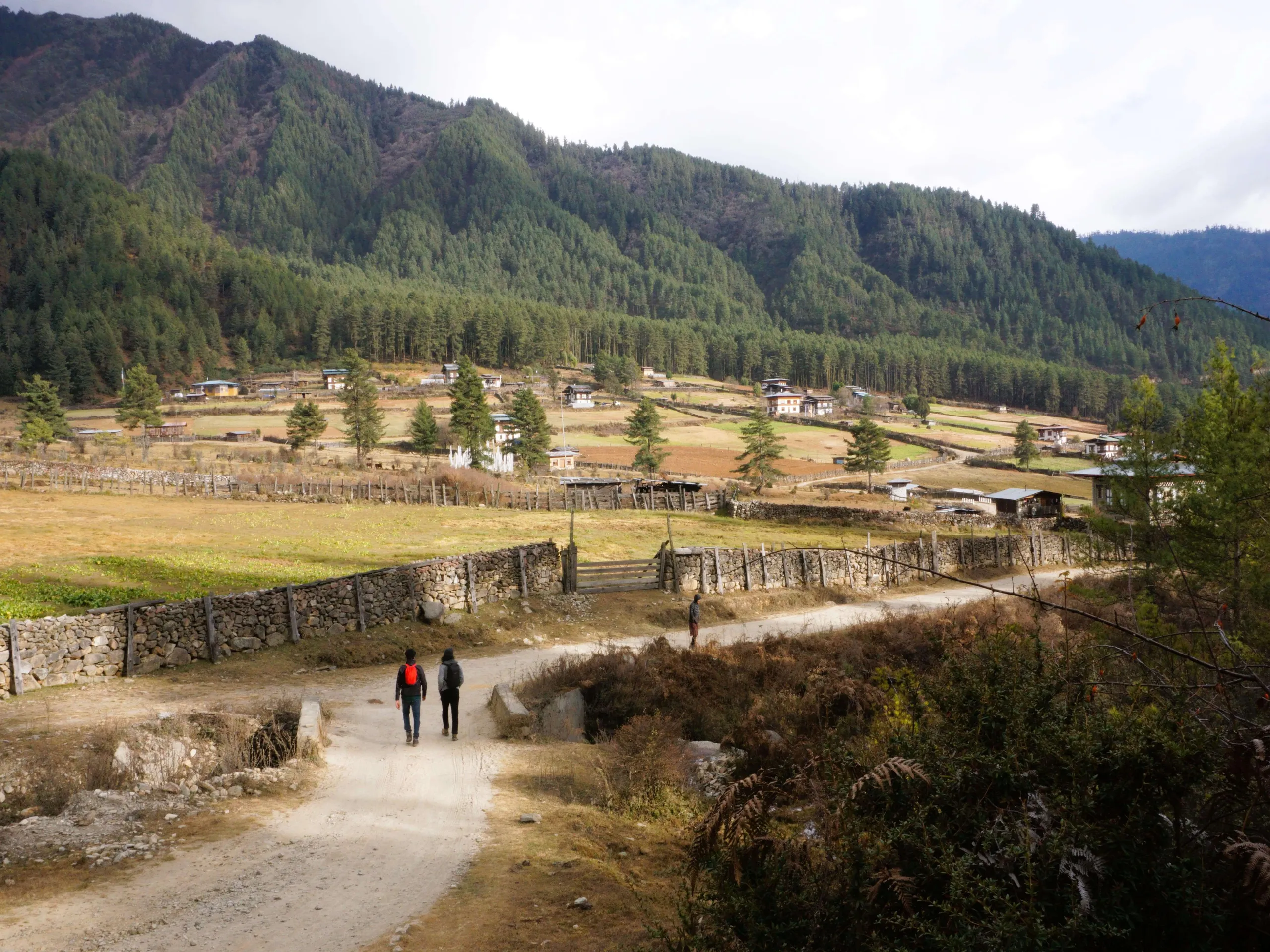
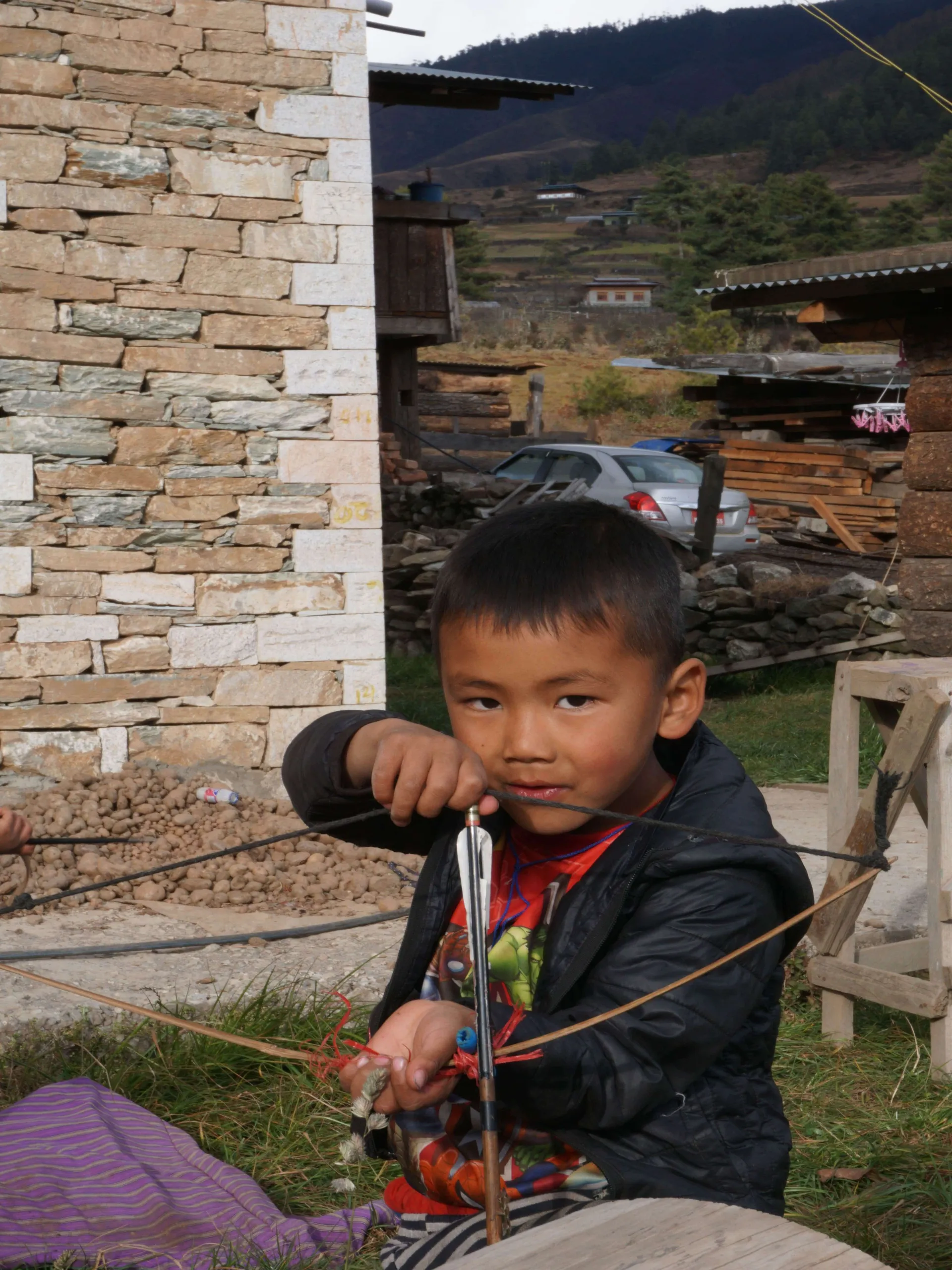
The trail started with a descent and in the backdrop, we could see the beautiful houses and the mountain. While walking across, I saw little kids playing archery. Within minutes we were inside the pine forest.
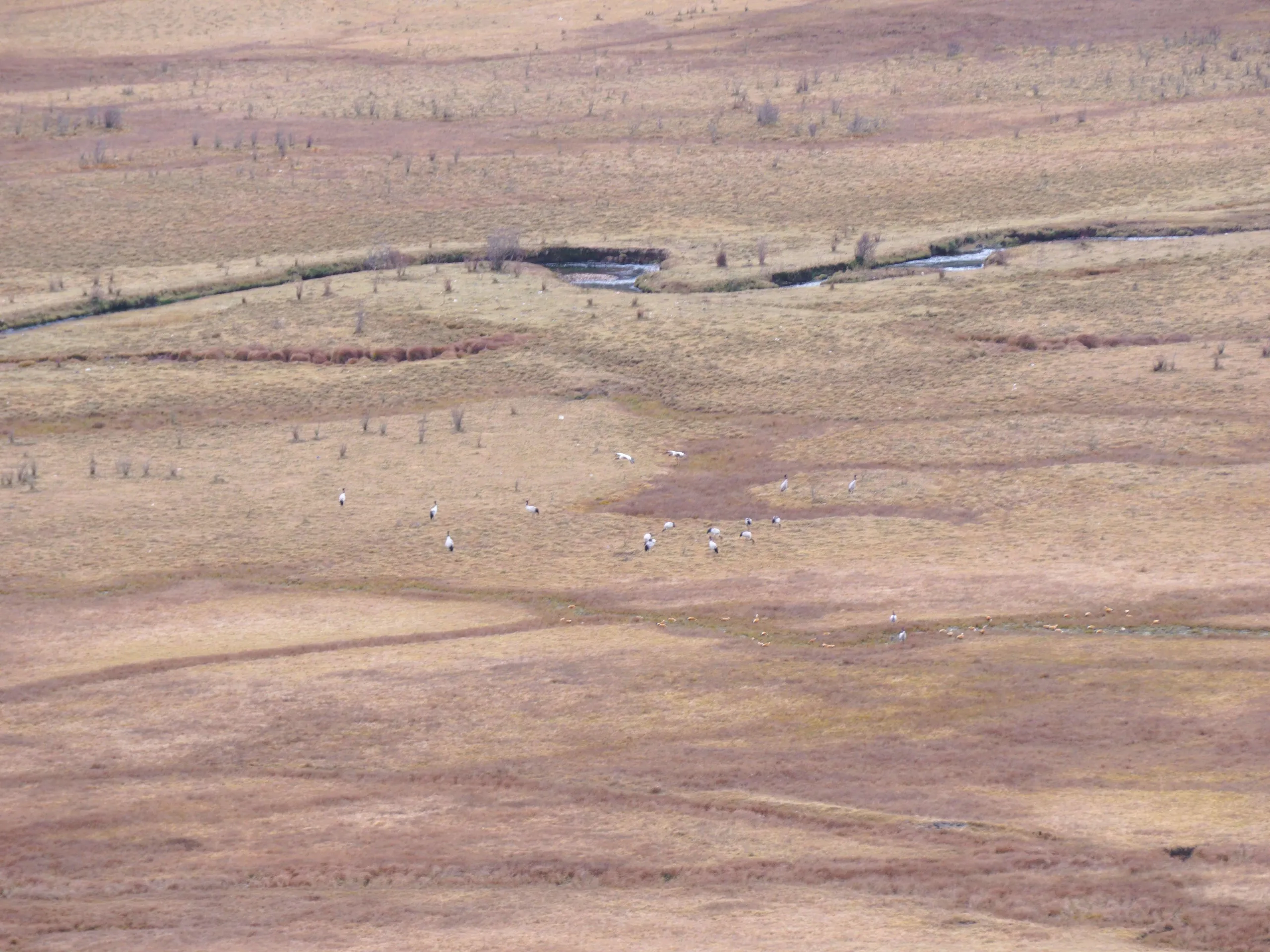
After close to 30-40 minutes of walking, we reached the viewpoint from where we could finally spot the Black-necked cranes. We could see a group of them but they were still very far in the valley.. We spent a good one hour at the spot there. As we kept walking the valley was looking even more beautiful.
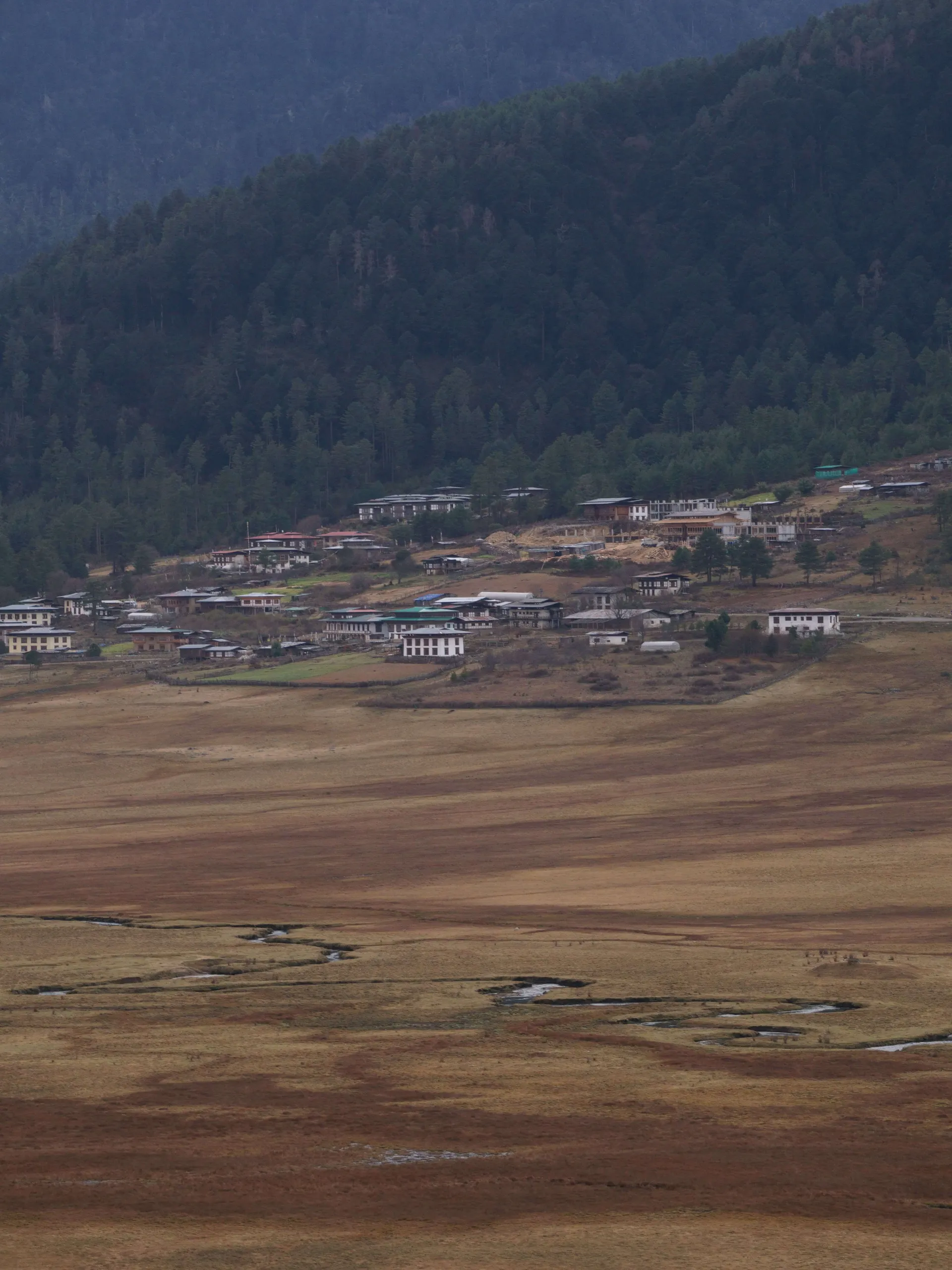
It was already starting to get dark, so we walked to the spot where Pema was waiting for us with the van. The resort was not far and was right in the valley.
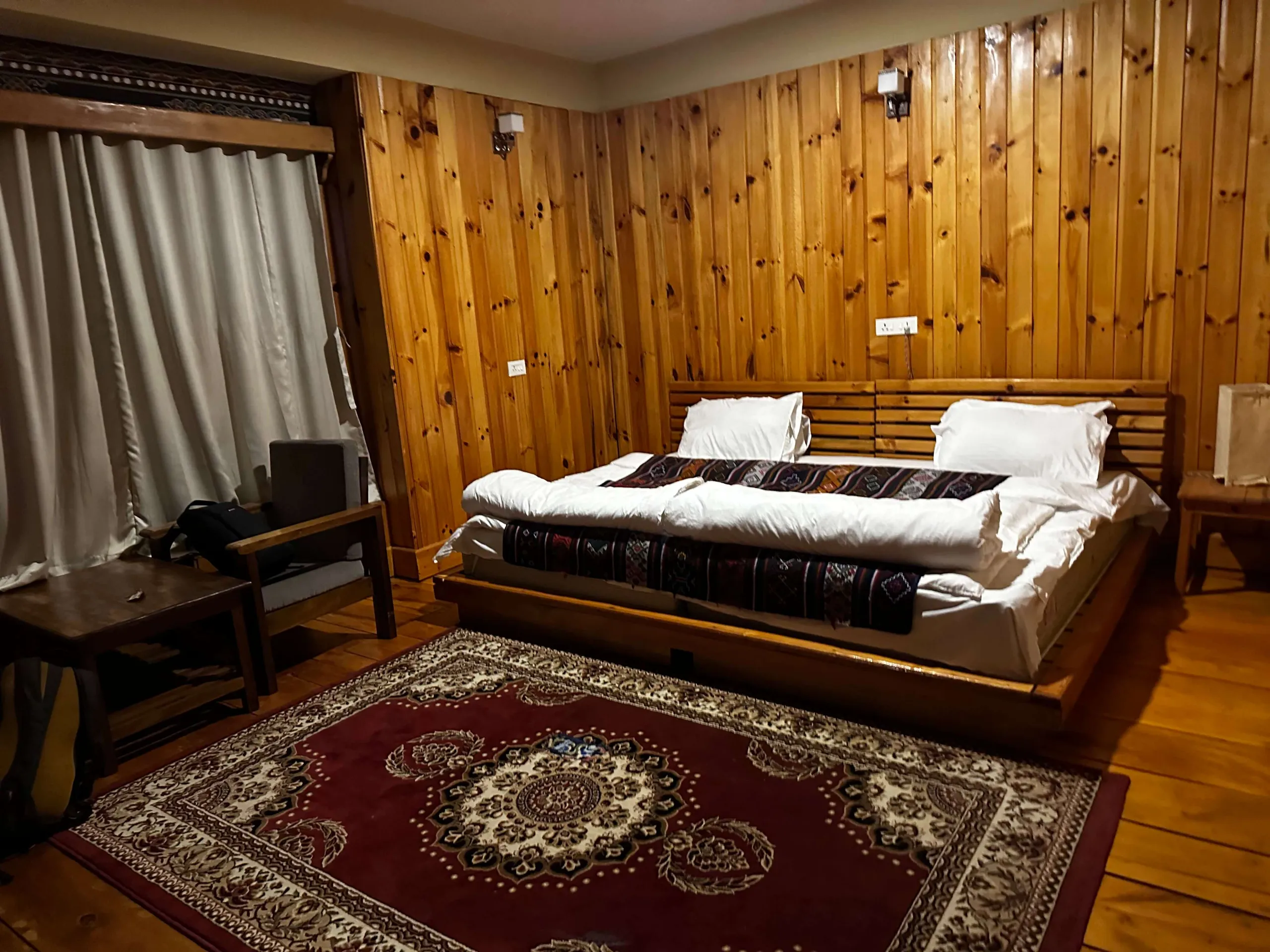
The mandatory rule of staying in at least a 3-star property could be one of the best decisions by tourism, I mean each hotel we stayed at was of top-notch quality. This room in Phobjikha was my favorite room and we even had a wood burner in the room.
Since there was not much to do, we had a quick dinner and slept early.
Day 6: Phobjikha the Switzerland of Bhutan
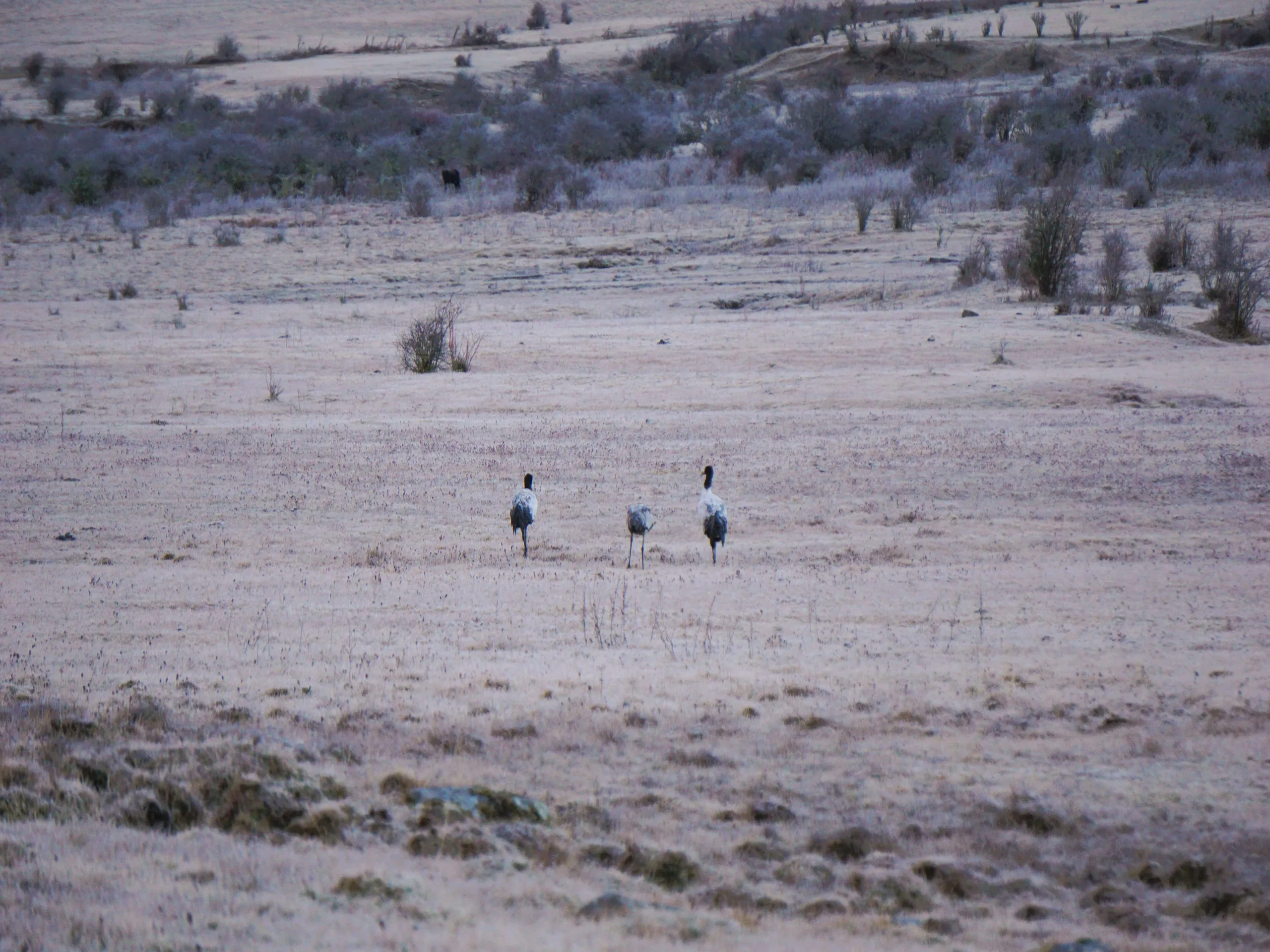
The next morning we woke up early, and everyone decided to go out for a walk. So all we did was take our gadgets and woolen caps and were ready to head out.
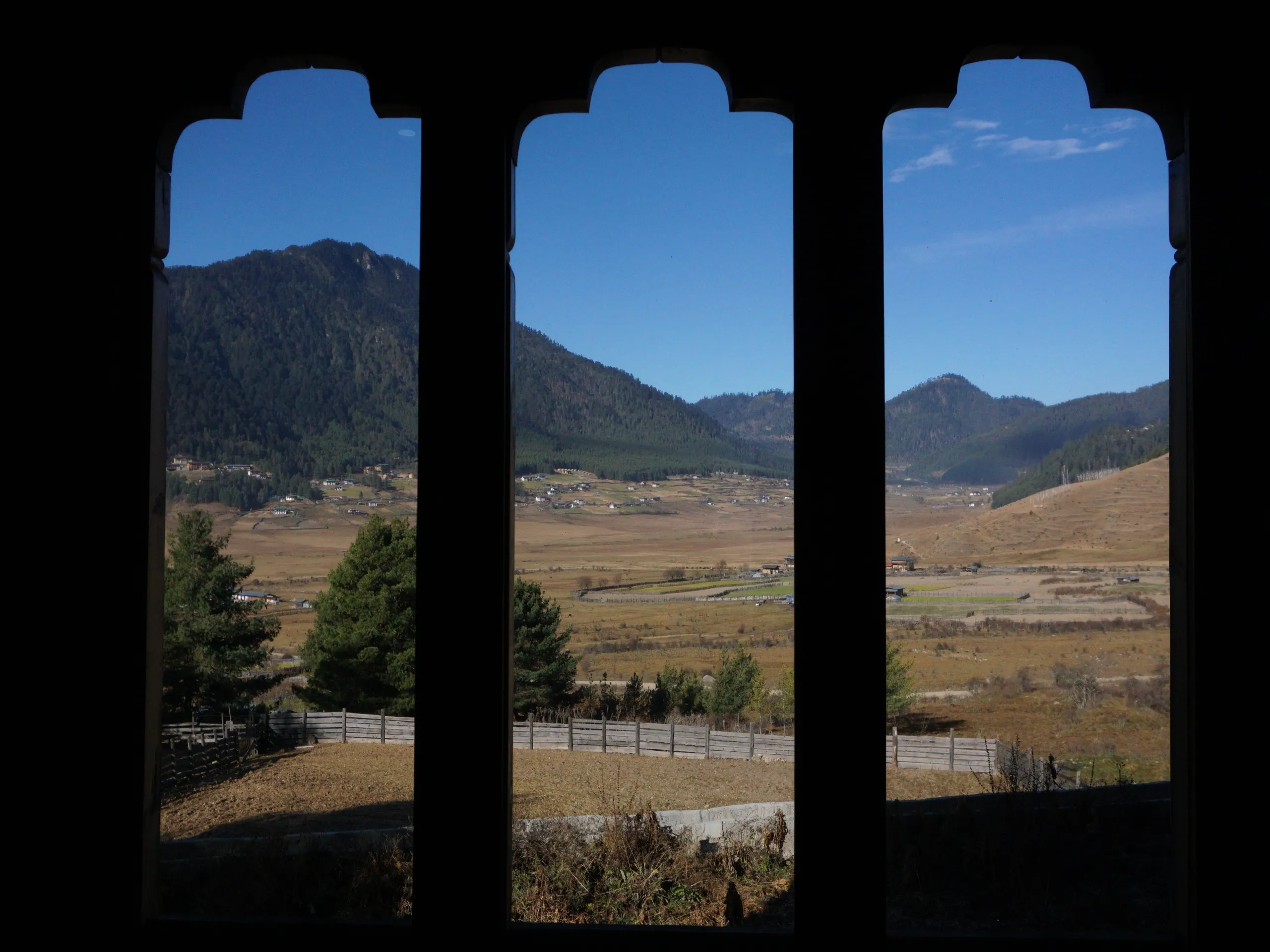
Since it was December the valley was very dry but to our surprise, we were able to spot the black-necked cranes, and this time they were even closer! We did spot a couple of yaks as well, overall a good decision to wake up early.
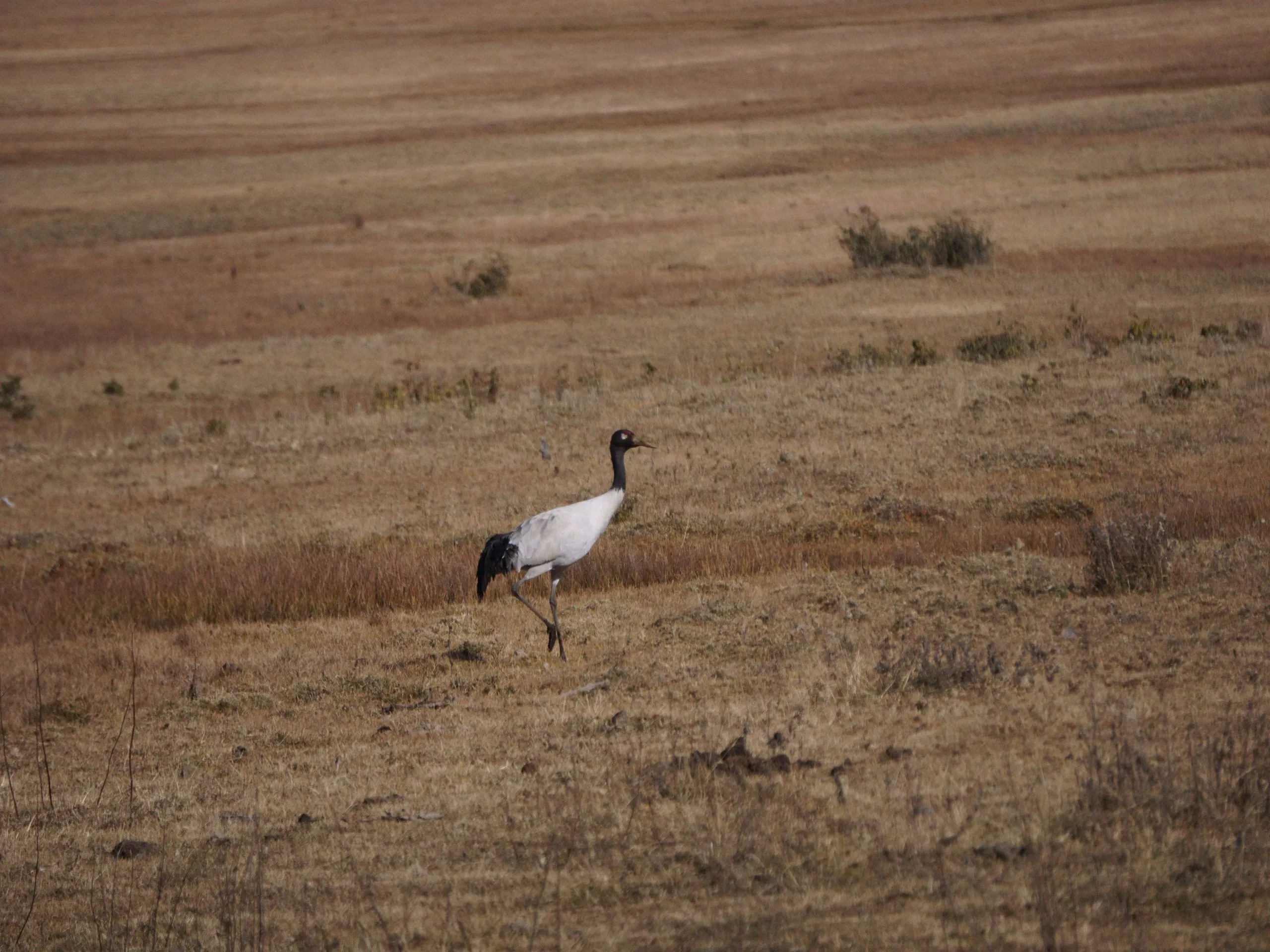
We had our breakfast and were already on the move, and just then we saw another group of black-necked cranes, and this time they were the closest. Our next stop was the black-necked Crane visitor center, where we learned in detail about the birds and their migration to Bhutan from Tibet during the colder months.

We were about to exit Phobjikha and just then, we had the best view of the valley. The valley left us stunned, imagine this place in spring with greenery. This definitely resembled a village from Switzerland. (Not that I have been to Switzerland, but based on the pictures).
Crossing the highest Lawa La Pass
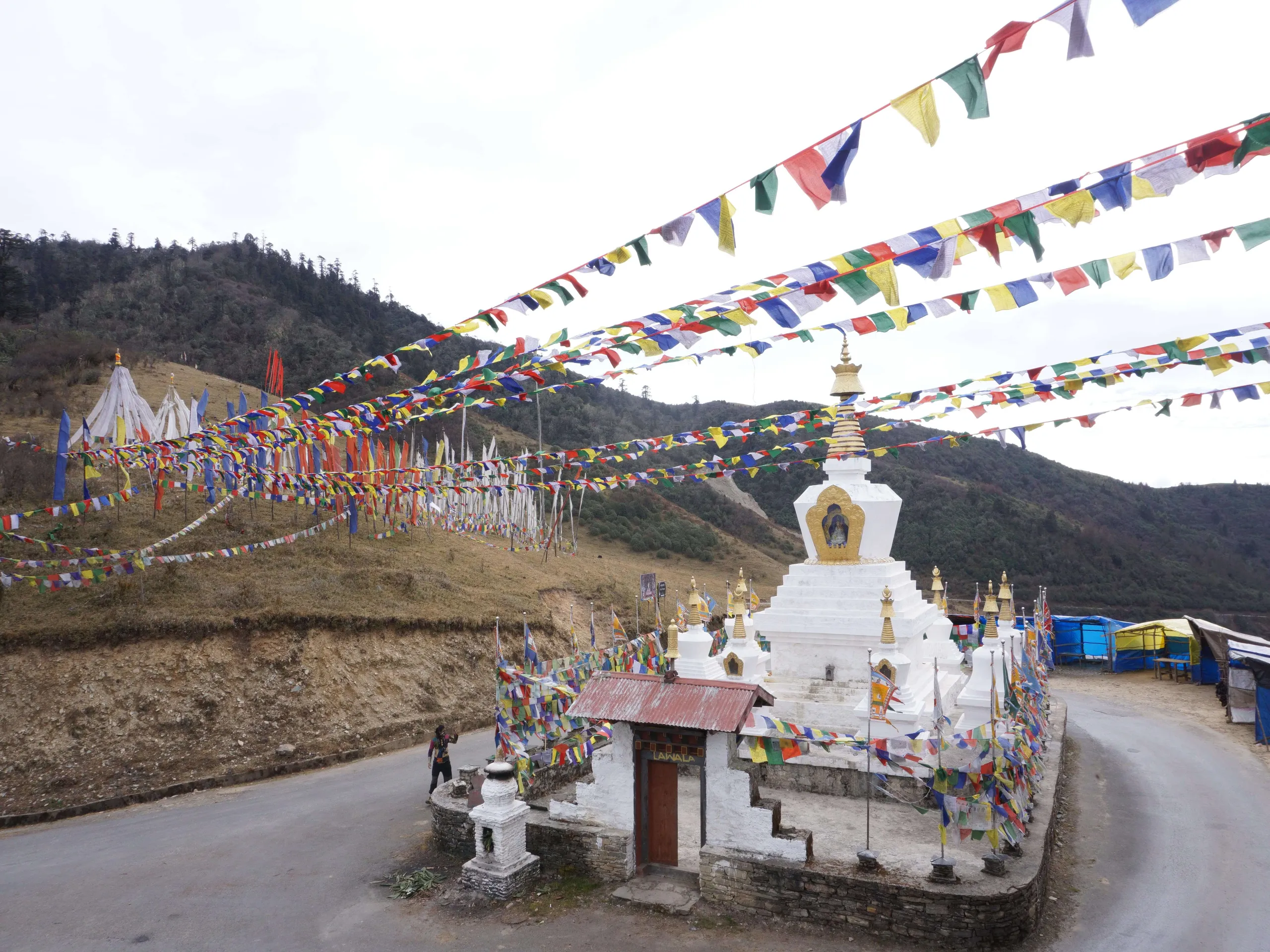
We were on to our last destination of the itinerary, the scenic Paro. From Phobjikha, it was going to be a 5-6 hour long journey. Just after exiting Phobjikha, we reached the Lawa La Pass, and this time we stopped here for a while. This was also the highest part of our itinerary at 3250m, we clicked a few pictures here and then moved towards Paro. Some shops were selling Churpi(the hardest cheese in the world) and Kuenzang got a piece for us to try.
Until we reached the Do Chu La Pass we kept chewing it, a great way to work on that jawline.
We had our lunch at the cafe on the Do Chu La Pass, the pass was quieter during this time. We had lunch looking at the mountain ranges and then again moved towards Paro.

In the evening, we entered Paro by 5 pm and this was the last time for us to do some shopping. So instead of going to the hotel, we wandered the Paro markets.
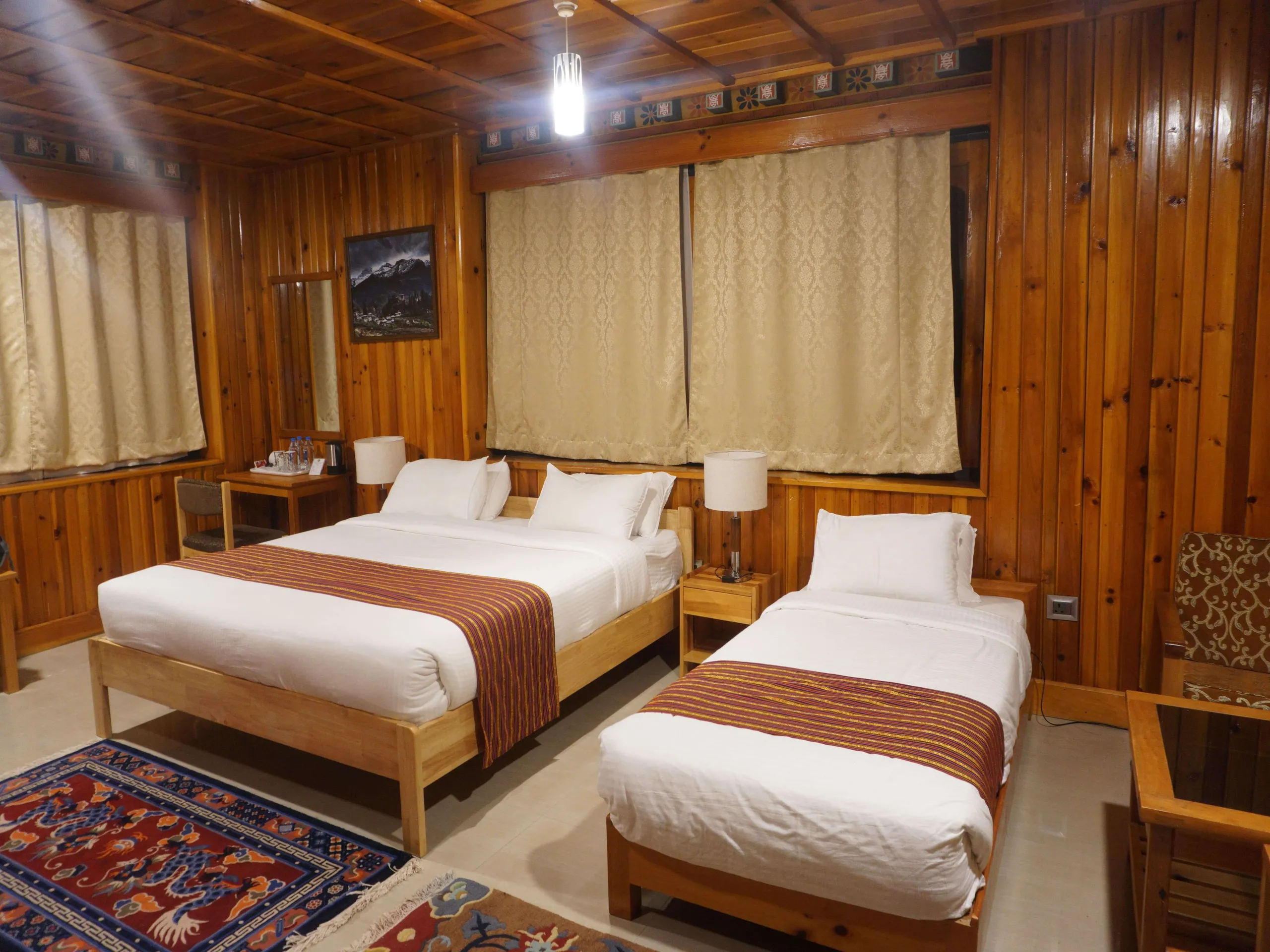
After shopping for close to two hours (yes boys can also shop for hours and even bargain) we were back at the hotels and had dinner early because we were going to visit the most iconic attractions on our Bhutan itinerary.
Day 7: Enroute Tiger Monastery
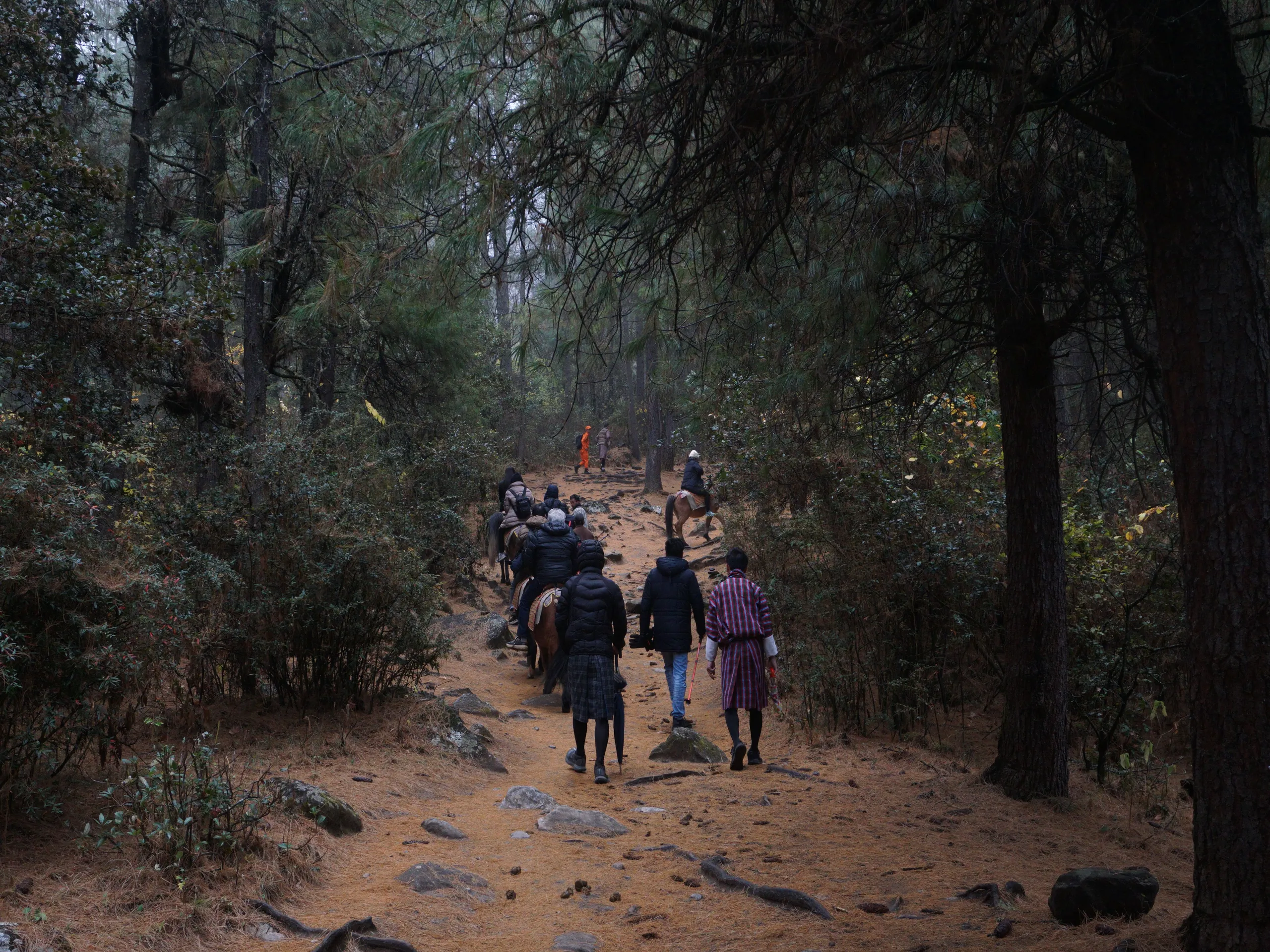
The next day, we were up early and reached the base of the monastery by 8 am. It was slightly drizzling when we were starting the hike and the monastery was all covered in clouds.
The Tiger’s Nest Monastery, also known as Taktsang Palphung Monastery, is close to a 6.5 km round trip and it takes close to 5-6 hours to complete this hike.
The hike started with a gradual ascent and we were accompanied by other tourists, some even chose to do it on a mule. The ground was a little slushy because of the rain but it was still comfortable to walk and there were also wooden logs that could be used as steps.
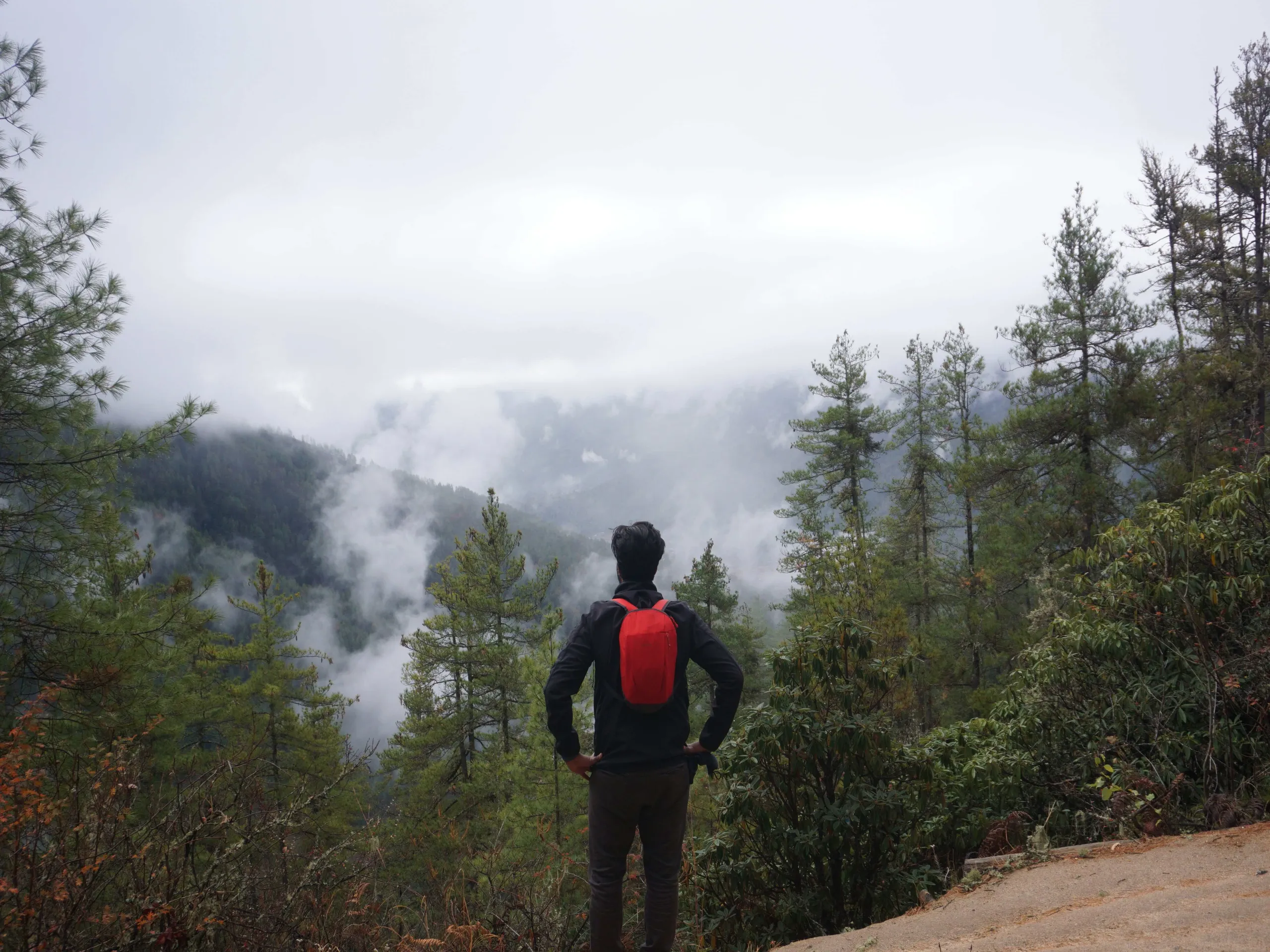
The mules were slowing everyone’s pace and after some time, Kunezang asked us if we wanted to go from a different route to escape all the mules. He also mentioned that this was a steeper climb compared to the other route that everyone was going on, to which we happily nodded.
The visibility was getting worse and the complete valley was covered in clouds. We kept walking until we reached the halfway mark. At the halfway mark was a cafe(resting point) where everyone was headed, since we were not tired we decided to skip it and continue walking.
Hide and seek with Tiger’s Nest Monastery

Continuing the hike was the best decision because now, it was just us on the trail, but the visibility was barely a few meters. We were hoping as we climbed higher we would be able to see the Tiger’s nest, but it was quite the opposite. There were multiple spots where Kunezang mentioned we would be able to see the monastery, but all we were seeing were clouds.
We had started to feel a little dejected, what if we didn’t get to see the Tiger’s Nest? A trip to Bhutan is incomplete if you haven’t visited the Tiger’s Gest. We were just a couple of minutes away from the monastery when the clouds cleared for a few seconds, and we barely got a glimpse of it. It was nothing like the images we had seen online.
We then decided to enter the monastery and visit all the temples inside. That’s when Kuenzang told us about the history of how in the 8th century Guru Padmasambhava(Guru Rinpoche) came to this place on the back of a tigress and spent 3 years, 3 months, 3 days, and 3 hours meditating in the cave.
There was a different sort of peace and calmness that I experienced and then we also meditated for a while.
Once we were outside the monastery, we saw the clouds disappear and the sun started to show up.
Photography doesn’t stop at the Tiger’s Nest Monastery

Only once we had climbed the stairs up to reach the photography spots all the clouds had disappeared and the sun was shining bright. We now had all the time to click as many pictures as we wanted and didn’t worry about getting late.
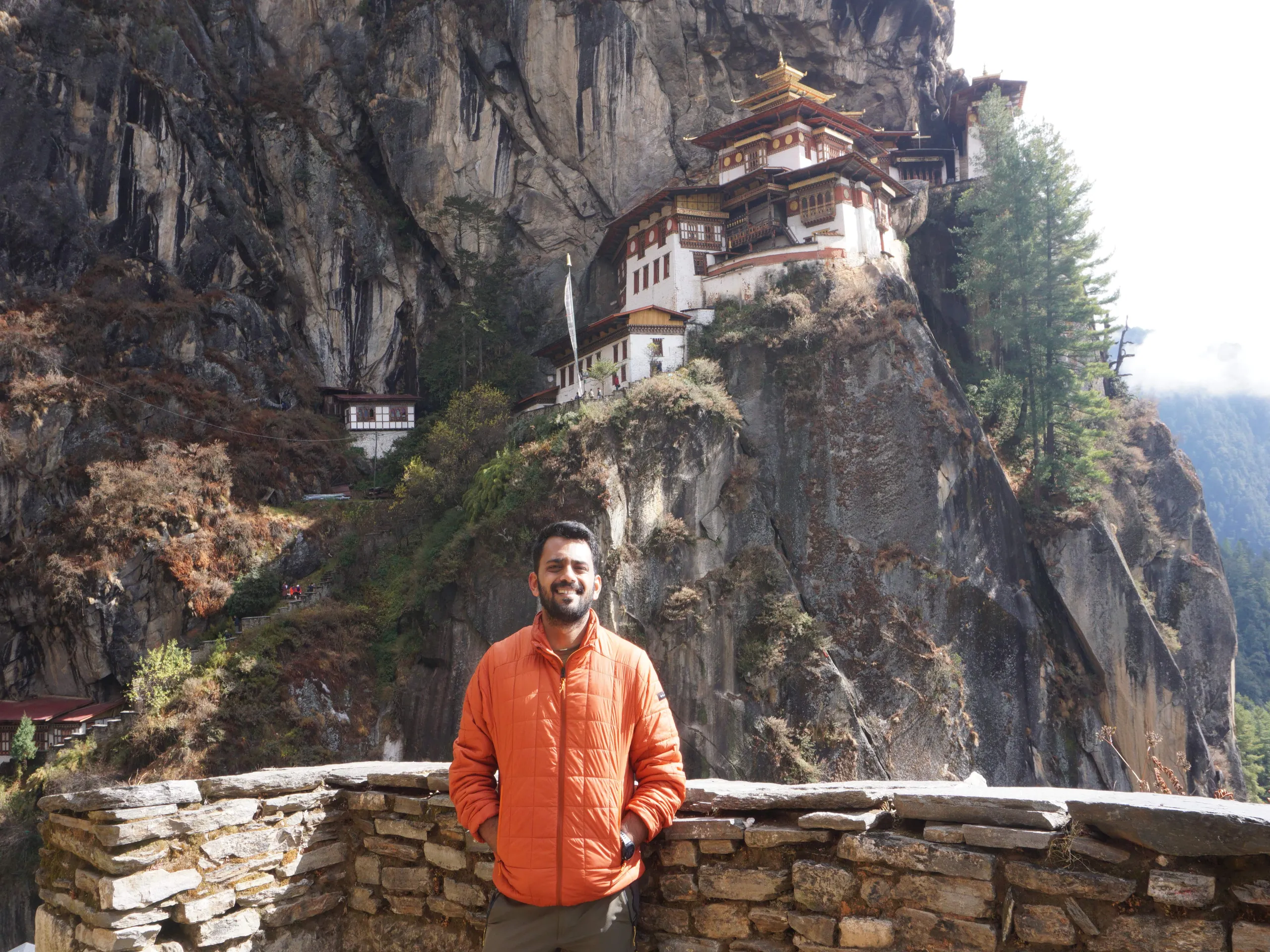
Overall, it turned out to be a good decision to not stop and continue the hike. We took close to an hour just taking pictures from different spots until we were fully satisfied with all the pictures.
While returning, we stopped at multiple spots to see the monastery which was covered in clouds on the way top. We even stopped at the cafe from where too we could see the Tiger’s Nest monastery. I have this bad habit of running as soon as I see a descent and within minutes we were at the starting point. We then realized one could also see the Tiger’s Nest monastery from the starting point of the hike.
We then went to Drukyel Dzong which was under renovation and could only see it from the outside.
Watching the locals play archery

On the way back to have lunch, we spotted a few locals playing archery. They were shooting arrows from almost 100 meters away and were still able to hit the center of the target, whereas we were not able to hit from 5 meters. After which we went to the town center for our lunch.
For a change, we were not having Ema Datshi, but rather another cheese dish – Pizza. After a lot of walking, it was time to load ourselves with some carbs.
We were on our way to the last spot, the Paro Dzong.
Boys suit up!
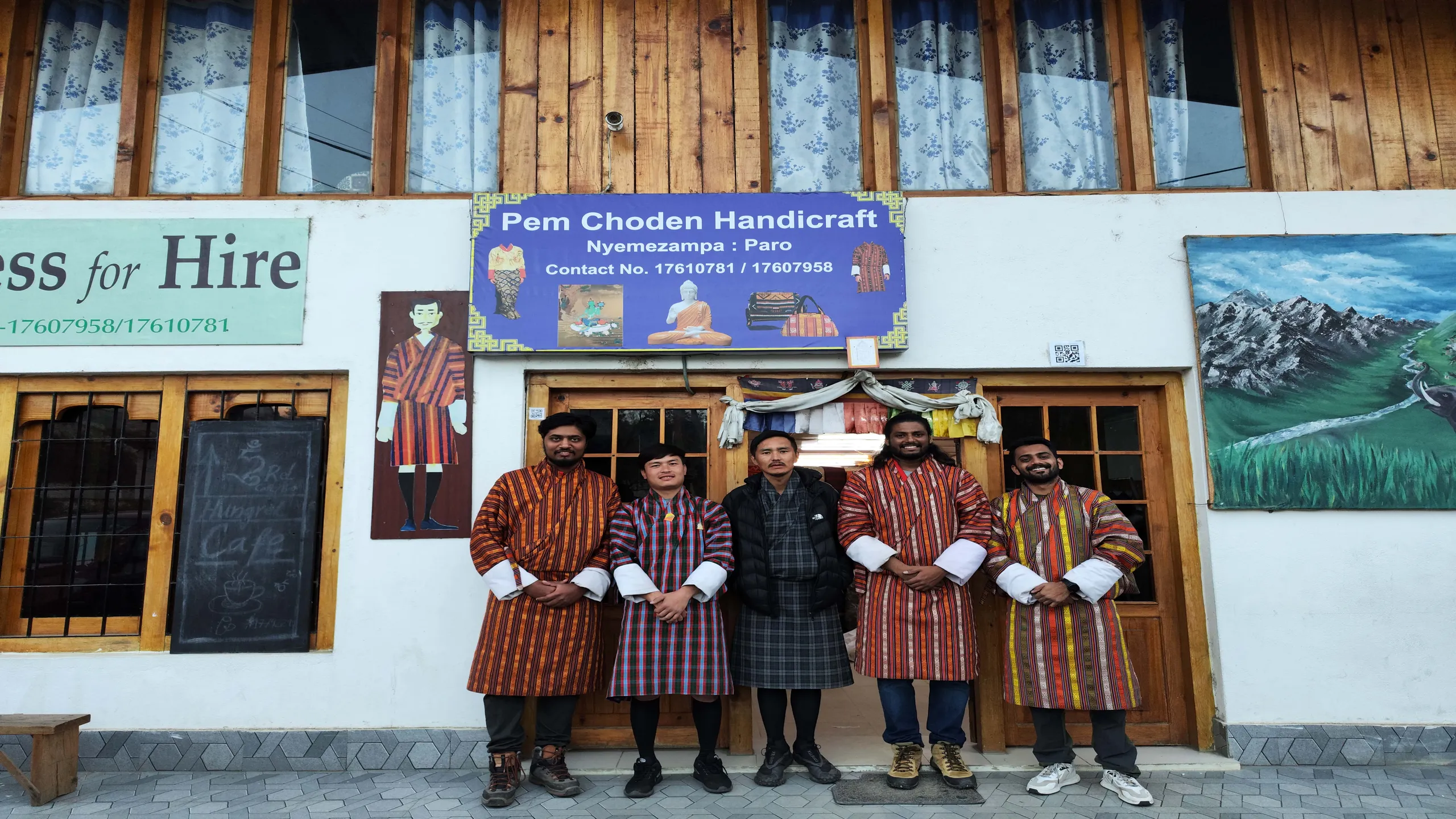
We had been wanting to try the local dress that our guides had been wearing all the time. It was finally time, just outside the Paro Dzong, was a shop renting the “Gho”. A trip to Bhutan is incomplete without this experience. All of us wore the Gho and clicked pictures at the entry of the Dzong and by the river.
After this, we headed back to the room and had an early dinner at the hotel. Pema then picked us up to show us the Paro Dzong at night with all the lights. After which we went to a pub where live music was being played. It was our last night in Bhutan, and it was a kind of bitter sad feeling that we had to leave this amazing country.
Day 8: Watching a landing at Paro Airport

The next morning, we left early as we had to cover 5-6 hours on the road to reach the border and another 4- 5 hours to reach back to Bagdogra. We had to make one last stop to see the Paro airport from the viewpoint. Paro airport is said to be one of the most dangerous airports in the world with only limited pilots allowed to land there, as it is covered by mountains.
Kuenzang just then checked that a flight would be landing in 30 minutes and we decided to wait there a bit longer to see the landing. When the flight was approaching all our cameras were glued to the flights and we could see the different turns it was making. It was a wonderful experience seeing the flight land and then we were back on our way to the border.
Goodbye to Bhutan
We stopped on the way for a quick lunch and reached the border by 3 pm. It was finally time to say goodbye to Bhutan, Kuenzang, and Pema. I would really like to thank Bhutan Druk Adventure who made this trip a wonderful experience and we got to see the raw beauty of the country, that Bhutan is. Bhutan has a lot of places to visit, but I hope this 8-day itinerary gives you a glimpse of Bhutan and helps you plan a beautiful trip.
Best time to visit Bhutan
While the best months to visit Bhutan are from March to May or September to December, it is even better if you can plan to visit during a Tsechu(festival). This way you’ll get to experience the masked festival but also get to know Bhutan more culturally.
What is the Sustainable Development Fees(SDF)?
Bhutan started shifting to a “Low Volume but High Value” form of tourism to limit the number of tourists to be able to protect the environment while working toward the goal of being carbon-negative by 2030. In 2022, Bhutan implemented the fee for Sustainable Development (SDF), which is charged daily to all foreigners visiting the country.
While the SDF is ₹1,200/day for Indians, for all the other nationals this fee is $100/day.
Bhutan Tour Operator Information

Since the implementation of SDF, Bhutan has made it compulsory to hire a guide and visit only with a local tour operator. I did this trip with Bhutan Druk Adventure and I had the best experience. If you’re looking for a tour operator for Bhutan, I would definitely recommend them.
You can contact them on them here
Website: Bhutan Druk Adventure
Contact no: +975 77608671(Whatsapp)
I hope all this information helps you to plan a hassle-free trip to Bhutan, if you have any more questions regarding Bhutan, please drop them in the comments below or DM me on Instagram: stories.of.raku
This post contains details of my experience with Bhutan Druk Adventure, who kindly hosted me during this trip. All opinions, thoughts, and recommendations are my own, and reflect my personal experience with the services provided.



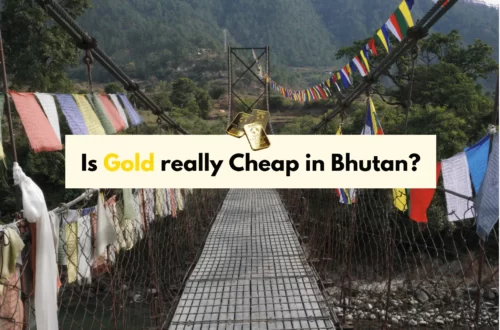
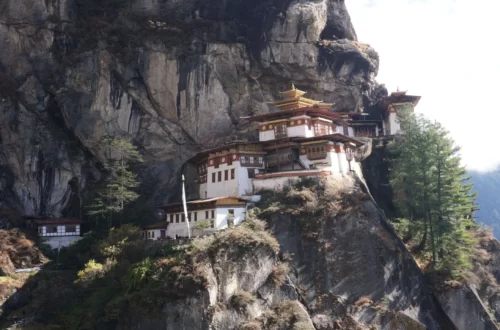
2 Comments
BONTHU ESWARA PRASAD
Nice narration and eloborate information provided by you.
I felt like i was traveling
Thank you
Tashi
Thank you for writing about Bhutan! As a guide here, I see firsthand how much visitors enjoy our peaceful way of life and deep-rooted traditions. Your post does a great job of introducing our country to those who have yet to visit. Hope to welcome more curious travelers soon!